Leica M Monochrom Digital Rangefinder Camera - Page 27
Index of Thorsten Overgaard's user review pages on Leica M9, Leica M9-P, Leica M-E, Leica M9 Monochrom, Leica M10, Leica M10-P, Leica M10-D, Leica M10-R, Leica M10 Monohcrom, Leica M11, Leica M11-D, Leica M 240, Leica M-D 262, Leica M Monochrom 246, Leica SL, Leica SL2, Leica SL2-S, Leica SL3, Leica SL3-S as well as Leica TL2, Leica CL, Leica Q, Leica Q2, Leica Q2 Monochrom, Leica Q3 and Leica Q3 43:
Leica M Monochrom Type 246
By: Thorsten Overgaard. June 18, 2015. Latest update December 23, 2021.
Add to Flipboard Magazine.
Old School is the New School
One of the intriguing things that happened in the months and years after Leica Camera AG introduced the Leica M Monochrom in May 2012 was that some people sold off their Leica M9 cameras and went completely Monomalistic
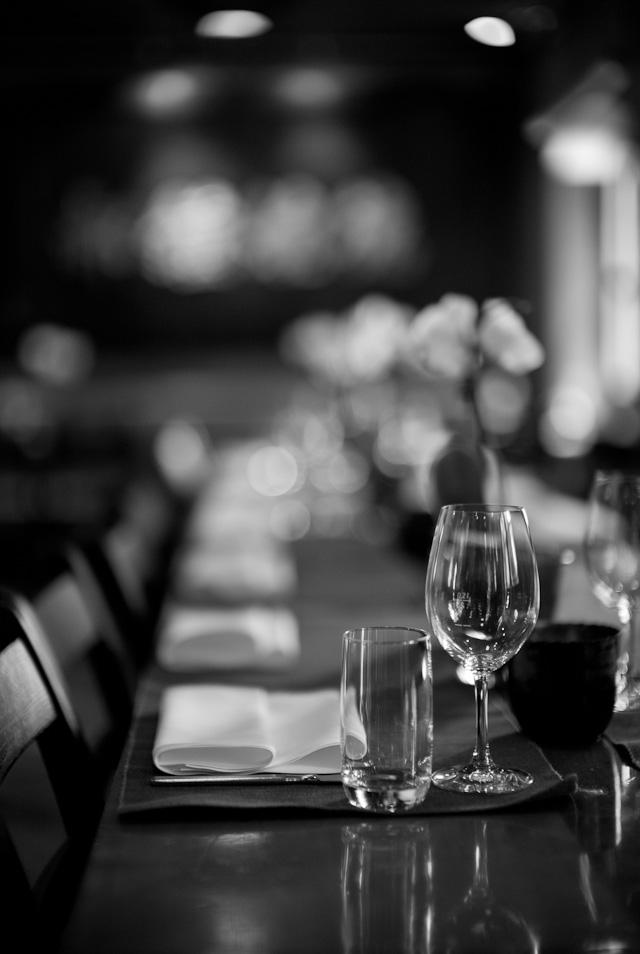
Inside Mangostin Asia restaurant in Munich. 3200 ISO. Leica M 246 Monochrom with Leica 50mm Noctilux-M ASPH f/0.95
All that mattered was the simplicity of black and white digital files. The camera itself, with the matte finish and discreet leather cover supported the idea that life is simple and beautiful. Uncomplicated and seemingly not cluttered by the technology that constantly asks you to make decisions on settings such as white balance, focus points and all the other things that don't matter when you are traveling down a one-way street in photography.
Just like the cult of vinyl lovers in music, there is a cult of film lovers in photography. The Leica M Monochrom was and is a daring new concept in modern technology: A high-tech product that simplifies things and gives less choices.
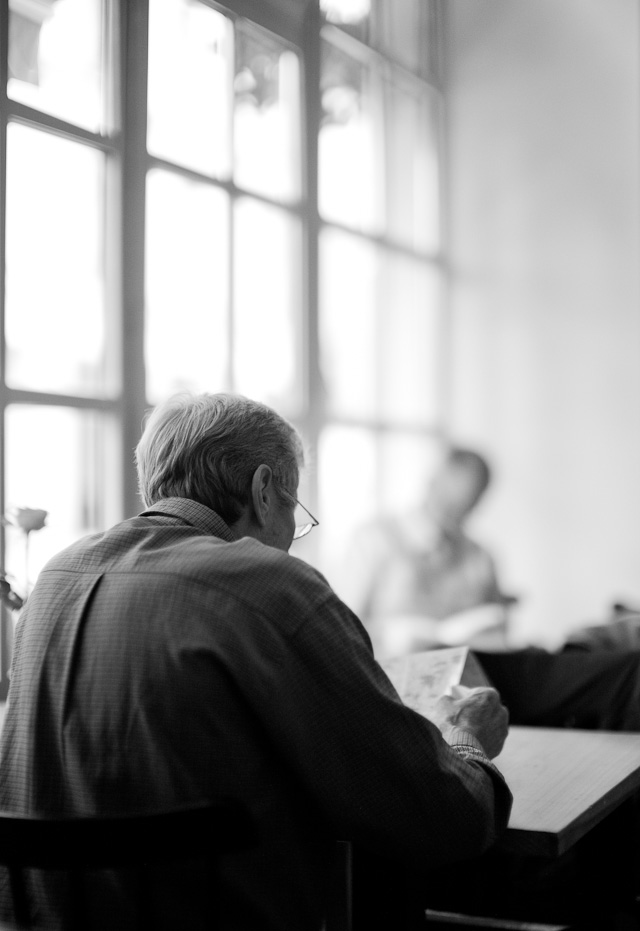
Taking a break at Prinz Myshkin vegan cafe in Munich. Always look for good coffee in an interesting looking place with good light. 3200 ISO. Leica M 246 Monochrom with Leica 50mm Noctilux-M ASPH f/0.95
| |
|
|
|
|
| |
Buy the new eBook
"The Freedom of Photographic Expression"
by Thorsten Overgaard |
|
| |
|
|
|
|
| |
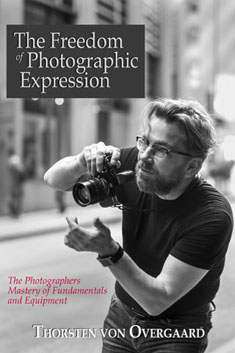
"The Freedom of
Photographic Expression"
eBook for computer, Kindle and iPad
Released March 2024.
First editon: October 2016
Now 303 pages. |
|
In this easy-to-read and easy-to-apply eBook,
Thorsten Overgaard takes beginners and experienced photographers through the basics of controlling the light and the camera.
This book covers the technical side of photography from beginners level to semi-pro, features a number of photographs by Thorsten Overgaard and chapters on his philosophy on photography.
Only $248.00
| |
|
|
| |
Buy Now

Instant Delivery. |
|
| |
|
|

|
|
| |
"I've bought the new book - made a start reading it - it is really interesting.
I know it’s basic at the beginning but it isn't written in a patronizing way. I have been taking photographs for many years and have been lucky enough to be paid to take them for the last seven years; but it's always good to be taken back to the start"
P. S. (UK) |
|
"Really enjoy your writing and teaching"
D. K. (USA)
"I love your insights on photography."
D.B. (USA)
★
★
★
★
★
★ |
|
|
Less is more. We all know. Film is cool, but once you develop the film, you realize that you don't have all the choices of editing and adjusting the image as you have in digital. You do have the possibility to tweak the film look, but then you would have to go into a real darkroom and make choices between different types of photographic paper offering hard contrast or soft contrast.
Most who shoot with film don't use a darkroom anymore, but have the negatives scanned. Not much change is possible then as to change of the look. The genius of the Leica M Monochrom is that you feel the simplicity of film, but you have the possibility of shaping the look of the final images by adjusting them digitally. Several layers of raw information in the DNG file, rather than one layer of information in a film negative. And you don't have to chase up film stock, carry film around and find labs that can develop the film.
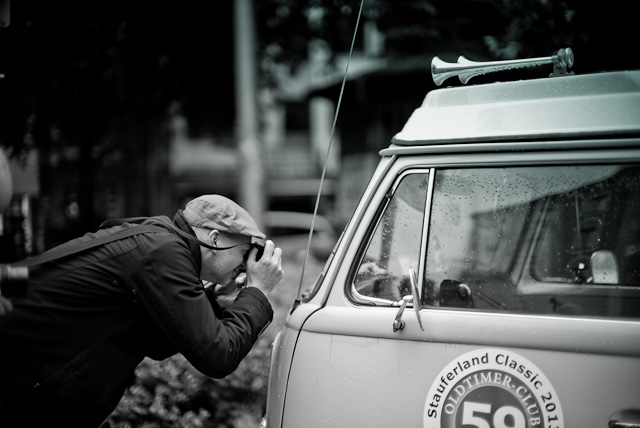
Harald Claessen found something interesting in this old VW parked in Pestalozzistraße in Munich. 400 ISO. Leica M 246 Monochrom with Leica 50mm Noctilux-M ASPH f/0.95
I, the Monomalist
The hard-core Leica M Monochrom user will go to extremes to simplify the photographic experience. Black leather strap (as it was supplied with the original Leica M Monochrom camera), a small stock of old and new lenses - preferable one old-school in fact - and the most important feature to complete the idea that time hasn't moved forward since the teenage years: Green, red, orange and yellow filters. Preferable the real Leitz filters from a good year, 1963 or something, far back earlier than present time!
Leica Camera AG spotted some of this trend and the new Leica M Monochrom Typ 246 was introduced along with a new line of color filters.
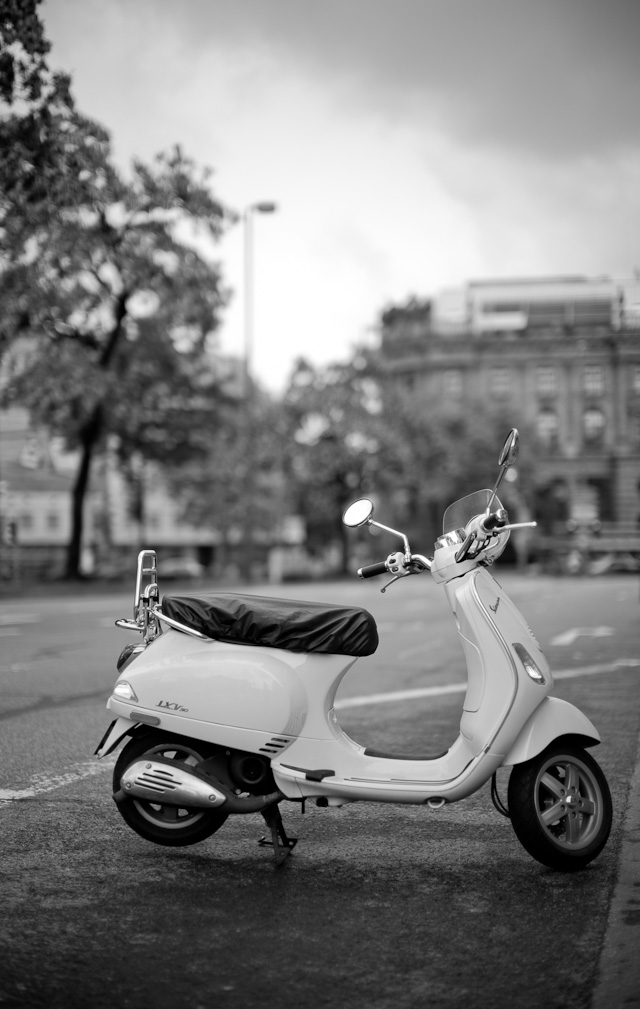
My daily Vespa. 400 ISO. Leica M 246 Monochrom with Leica 50mm Noctilux-M ASPH f/0.95
I personally think Leica Camera AG should have introduced ND-filters (Neutral Density filters that reduce the amount of light that enters the lens; so as to use low-light lenses in sunshine without having to stop down using the aperture). And I further think Leica Camera AG should supply each box of Leica lenses with a complimentary ND filter. It wouldn't hurt to add a $120 ND filter to a $11,000 Noctilux lens. Those filers are almost as hard to find as the lenses themselves!
Leica Camera AG has been producing UV-filters since the stone age, so Leica users could avail themselves of the best glass to protect the lens. Something that is not recommended for a Noctilux lens (because it causes reflections) and something I find unnecessary for any lens. Though, I understand that if you feel less vulnerable with a UV-filter, go get it. But I don't use them.
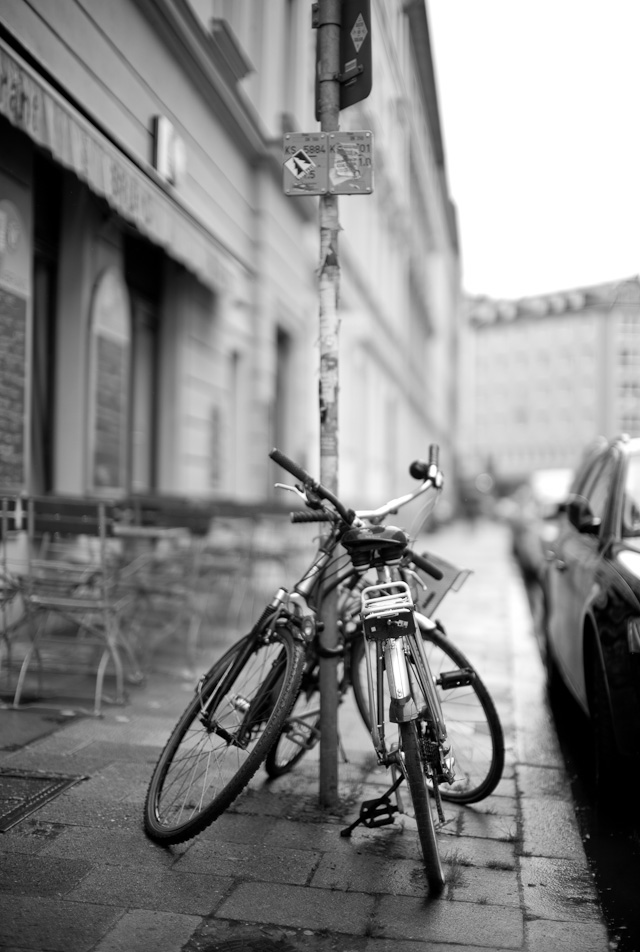
Bicycle-kiss in the rain of Berlin. 400 ISO. Leica M 246 Monochrom with Leica 50mm Noctilux-M ASPH f/0.95. © 2015 Thorsten Overgaard.
Unpacking the new wonder
The first sign that something is not quite right with the Leica M Monochrom 246 appears in the unpacking of the camera. The box is the one with magnetic opening and drawers that hold chargers, cables and all in different elegant compartments.
In one of the drawers I found the devastatingly standard Leica nylon strap!
A what?
A cheap nylon strap! I was so disappointed that I drowned my sorrows in color with a bright yellow Leica X a-la-carte strap as far from the style of the nylon strap as I could get.
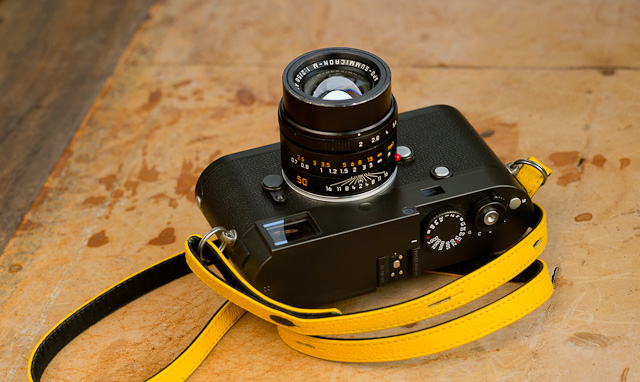
I managed to change the horrendous nylon strap (not pictures, shudder) into a flashy yellow strap from a Leica X A La Carte in the Leica Boutique Salzburg.
Supplying a nylon strap in what should be the celebration of Monomalistic lifestyle is a warning sign. It tells me that Leica Camera AG hasn't fully understood the customers who - faced with the choice of all the worlds cameras - are more than happy to pay a premium price of $7,450 to not have the colors, auto focus and 250 features with exotic names.
Servicing a clientele of people who are willing to pay almost any price for superior quality and simplicity from one of the few brands in the world that doesn't cut corners ... why would you economize?
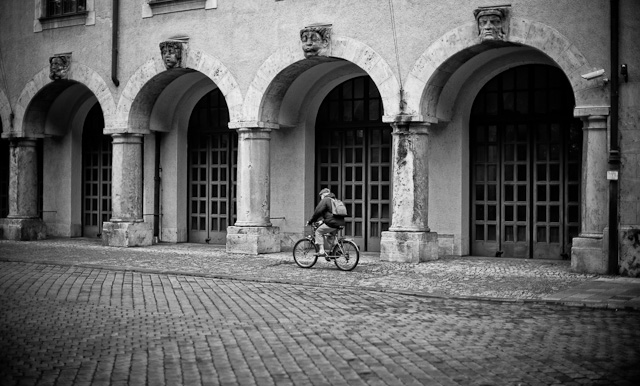
The fire station in Munich. 400 ISO. Leica M 246 Monochrom with Leica 50mm Noctilux-M ASPH f/0.95
Had Leica Camera AG fully understood and appreciated the new Monomalistic clientele, they would have made the experience special. It's not that the box the Leica M Monochrom 246 comes in is cheap, it's just that it is like any other box from Leica. And it is not that the nylon strap isn't good, it is just that it isn't special.
Don't they know at Leica Camera AG that the Leica M Monochrom is a special camera?

Following the turn of tide: A regular guest at the LiteraturHaus Berlin is this gentleman who arrives stylish in linen suit every day with his two leather suitcases, notebooks and papers. He spends his time reading New York Times and Die Welt whilst having breakfast and - occasionally - a cigar. 320 ISO. Leica M 246 Monochrom with Leica 50mm Noctilux-M ASPH f/0.95
What is it that is so special?
I am not talking about buying experience or the need for having served espresso in a gold-plated cup while the staff wrap the new camera in four layers of silk paper and lay it down in a brown box with red velvet inside and ask if I would like to keep the white gloves to unwrap it when you get home.
The creative photography – or some would say artistic – is different than documenting and freezing reality. A lot of cameras are made for documenting reality as close to reality as you can come.
The Leica M 246 is so far from the idea of duplicating reality as you can get with a high-tech camera. The world is not black and white, and yet that is the only that the Leica M 246 sees.
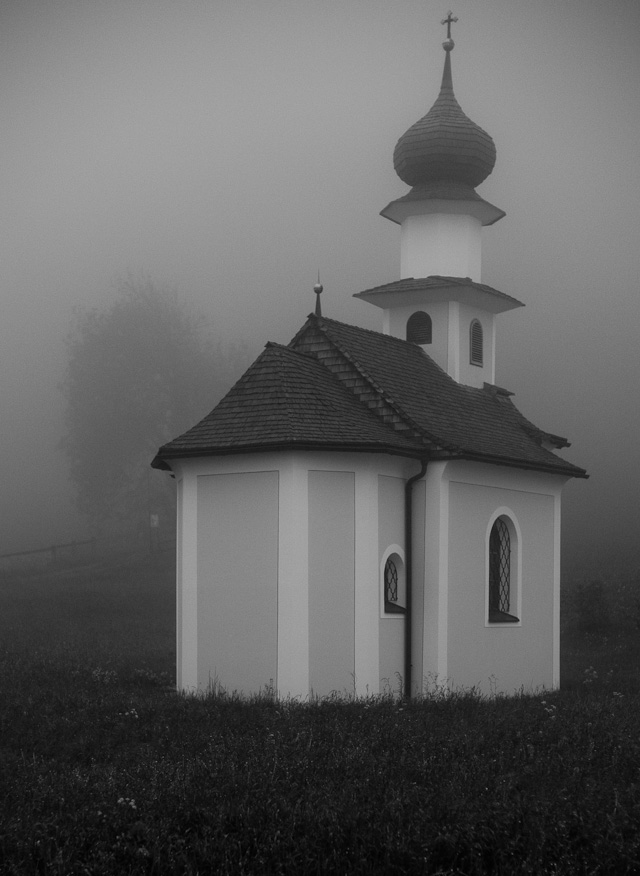
On my way from Italy to Germany I stopped for the night on a hillside in Austria. The sun was going down and the mist came down the mountains. Opposite the hotel was this small church building that looked as if the owner had decided to built a church for just one person. 3200 ISO. Leica M 246 Monochrom with Leica 50mm Noctilux-M ASPH f/0.95
This should also free us from trying to test if the camera actually sees the world as other cameras do. What is the essential criteria of the Leica M 246 is if it works as a tool in an artists hand to make things look the way you envision them.
Or perhaps even better; if this tool enables you to become an artist and make you see and create things you would like to see.
Some times a camera, like a new instrument as the synthesizer in the 1970’s, inspires the artist to see and make new things.
The error many reviewers make is that they think photography has to do with framing reality.
A camera is not a tool to conform to reality but a tool to make a new one. Your own.
The Leica M 246 is fundamentally a tool to do just that. It’s a tool for freedom of photographic expression.
People get a Monochrom camera and sell off their color camera, buys an open sports car, yellow filter and a hat and start exploring life.
Leica hasn't recognized this, and this explains the nylon strap and a lot more!
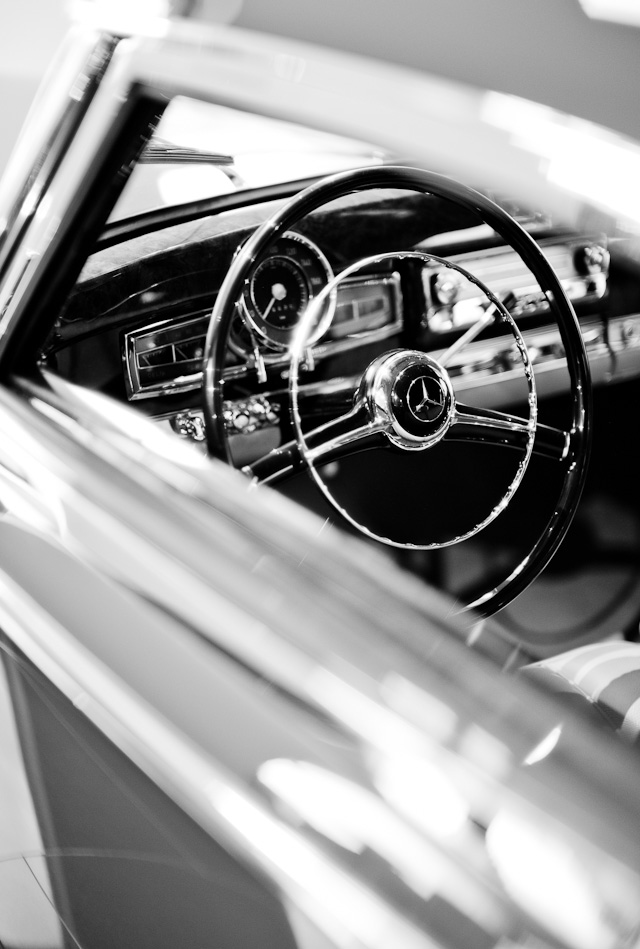
A new Mercedes from 1951 in Munich. 1000 ISO. Leica M 246 Monochrom with Leica 50mm Noctilux-M ASPH f/0.95
All you need is Love
I am basically against comparison of sensors, lenses and cameras. At least when it continues for too long and too detailed.
You can do monochrom photographs with the Leica M 240 (which I shall get into in a later article on how to do b&w with the M 240), and probably with a Nikon as well. At least nobody else will be able to tell what is what.
Nobody can really tell. That's why we indulge in scientific side-by-side tests comparing one and the other sensor.
But really, it doesn't matter.
It is the feeling of having the right camera, to hold and use a Leica M 246 that makes you see things, and then you create the magic.
You fall in love with a camera and a lens, and then you use it. If you find yourself visiting the same website evening after evening to drool over a lens or camera, it means that you are in love with it.
For me, I just couldn't get that damn thing out of my head. So I bought one.
| |
|
|
|
|
| |
Buy the new eBook
"A Little Book on Photography"
by Thorsten von Overgaard |
|
| |
|
|
|
|
| |

Order now - Instant delivery.
More info
★
★
★
★
★
★ |
|
It's a humorous understatement to call this
new eBook by Thorsten Overgaard for
"A Little Book on Photography".
It's a grand book, a history lesson, life experience, a biography and poetry book and brilliant photo book!
All in one beautiful package of 180 pages
to fire you up and get you to love
photography ... unconditionally!
"A Little Book on Photography"
eBook for computer, Kindle and iPad.
New release March 2017.
Intro price only $47 - 180 pages.
| |
|
|
| |
Buy Now

Instant Delivery |
|
| |
|
|

|
|
| |
|
|
Mind you, the photographer brings talent and love for what he does, along with a vision of what he wants to do. And all a camera does is a recording of light.
So how tricky can it be?
It’s really not a matter of camera megapixels, features, price, brand or any other thing. It’s simply matchmaking between a photographer and the piece of equipment he or she will fall enough in love with that he or she will use it to capture photographs.
Of course, most people fight with equipment they don’t love, even less understand. And that goes for professionals to the same degree as any other photographers. I’ve seen professionals ask others “I wonder what this button is for” or “now, what does that mean” or “how do I…”
If you listen to the man in the photo store rather than yourself, that's what you end up with. The camera of the week.
When all you need is love.
Most professional photographers either don’t lift their camera unless they are paid or told to. Others buy new equipment and study it in field use, as if they were biologists faced with a new race of insects.
Which is not, it is simply not, LOVE for the photograph.

Munich windows shopping. 400 ISO. Leica M 246 Monochrom with Leica 50mm Noctilux-M ASPH f/0.95
True love for photography means that you take any piece of equipment, and then you believe in it and make the best out of it.
If you’re not a photographer, you will take a piece of equipment and learn it so well you can tire all your friends with long talks about all the new features of this piece of equipment.
Or you write a critical review about the faults that prevented you from taking all the photos that camera was not designed for.
I guess what I’m saying is as simple as this: Find a camera you will love to take out for a shooting, one you will be proud to wear and use. One you feel has something special (perhaps something only you have seen or know about).
I often take underdog equipment. When others use an AF 70-200mm tele zoom, I use a 90mm manual focus lens. Because I feel the underdog equipment has some qualities that will make greater photography (and more fun and satisfaction) if and when it works, than if I just did as anybody else and pointed a Canon with a 70-200mm lens towards the subject and did 8 frames per second.

Andreas Rusch in Berlin with Leica M 246. 320 ISO. Leica M 246 Monochrom with Leica 50mm Noctilux-M ASPH f/0.95
One of the advantages of the Leica M 246 is that it is limited. It’s manual focus, it’s black & white, it’s 3.7 frames per second (till the buffer fills up).
The only explanation for buying and using it, is love. It is not that it is a great camera. It's a Leica M 240 designed in 2012 with a black and white sensor and a nylon strap.
But I love that thing.
Another underdog camera was the Leica Minilux which is a small Leica film camera with a 40mm auto focus lens. It’s basically a point-and-shoot camera, but very well built, with a soundless shutter and film rewind – and with the most incredible 40mm lens ever put on a camera. I used to take take that one out for a swing, and after few minutes it’s the type of camera you would love to travel the world with, doing a book or something.
Here’s a shot of my son I did one day. I did three shots that day that I have sold many times since. Because I thought it was a great camera and I wanted to wear it that day.
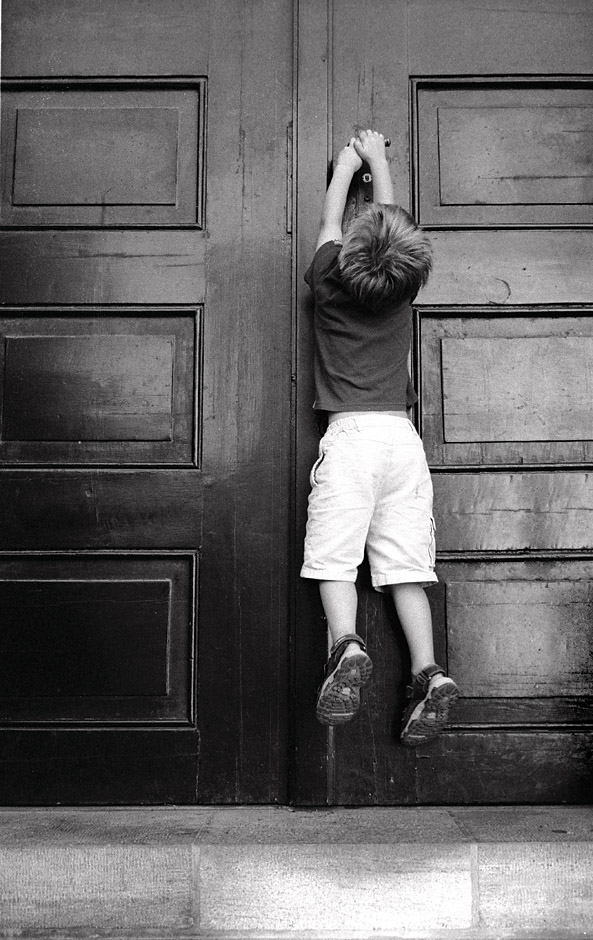
Leica Minilux film camera. My son oliver hanging in a church door in Copenhagen, 2001.
Love, you see.
It’s always a chance taking a camera and lens when it is underdog equipment. You should take a backpack with lenses and two camera bodies so you are well prepared for anything.
Don’t miss a thing.
But some times the point is to miss most of it and focus on what is in front of you and what is possible with what you got.
Do what you do when you are doing it.
The cameras I have, I love. It’s all Leica because I believe it’s the best. All my cameras have different personalities, styles, good and bad things. But I guess what they have in common is that they were made for photography, not to impress and overwhelm with 200 buttons. They simply lack buttons and complications. I don’t have any Nikons or Canons because I feel stupid using them. Everybody basically feels stupid using something so complicated they cannot completely understand it.
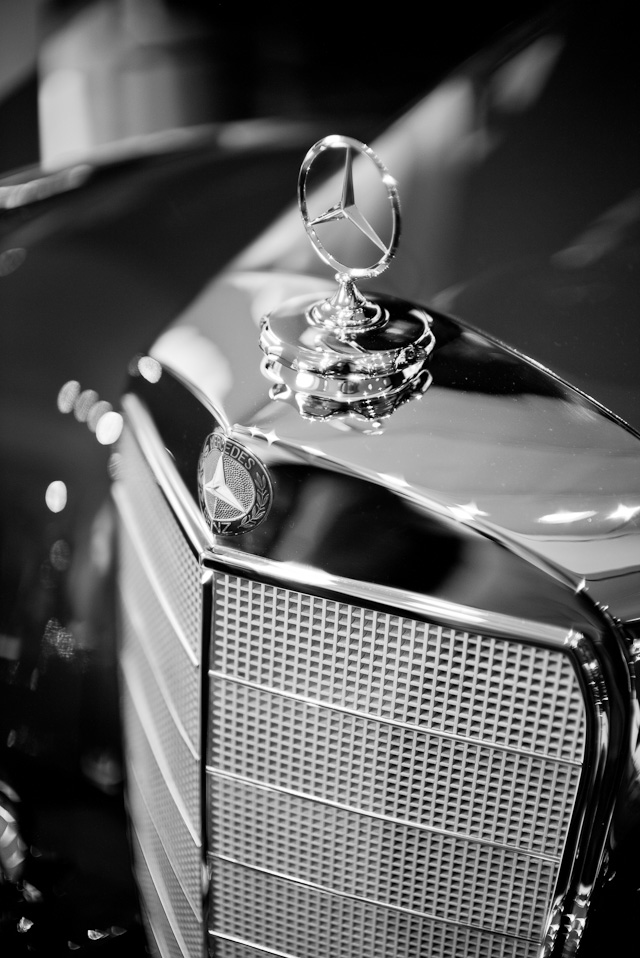
1000 ISO. Leica M 246 Monochrom with Leica 50mm Noctilux-M ASPH f/0.95
I’m supposed to get a Sony camera one of these days and plan to find a shortcut through the complications of that one. Make it simple to use by focusing on few essential features and make it work with those.
Some people feel convinced they are in love if the price tag is huge enough. Some require their camera to have a certain size before they feel comfortable and professional. It’s all right, as long as the end result is love.
| |
|
|
|
|
| |
Buy my "New Inspiration Extension Course"
|
|
| |
|
|
|
|
| |
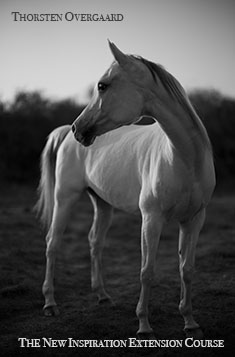
Need more info?
Read this article. |
|
Get inspired and rebooted!
This extension course if made for you! It can be done at home and travel at your own pace. I have taught workshops for years and the Overgaard New Inspiration Extension Course is my experience compressed to a package of training, articles, drills, assignments and video tutorials that will inspire you and take your photography to the next level! For a limited time my course includes something you cannot get anywhere or anytime else:
A portfolio-review by Thorsten Overgaard.
| |
|
|
| |
"The Overgaard
New Inspiration
Extension Course"
For computer and iPad. 181 p eBook. |
|
| |
Only $798 |
|
| |
|
|
| |
 |
|
| |
|
|
| |

|
|
| |
|
|
Order now - Instant delivery. |
|
| |
|
|
|
|
The camera made for you
In a way, that is the essence of love in photography: That you have this silly camera or great camera, but you truly believe it’s made for you and gives you the chance to make something unique and special. Together you can conquer the world. That’s love. And that is the camera you should be looking for.
Read all the reviews you want to, but when you hold a camera in your hands that you don’t feel love for, dump it. On the other hand, when you find one that feels like the right one, go for it. Even if the shop owner tells you it’s last years model, it’s overprized and the new Pentax is a way better offer this week and all that
The one that feels right is the one that is right. As simple as that.
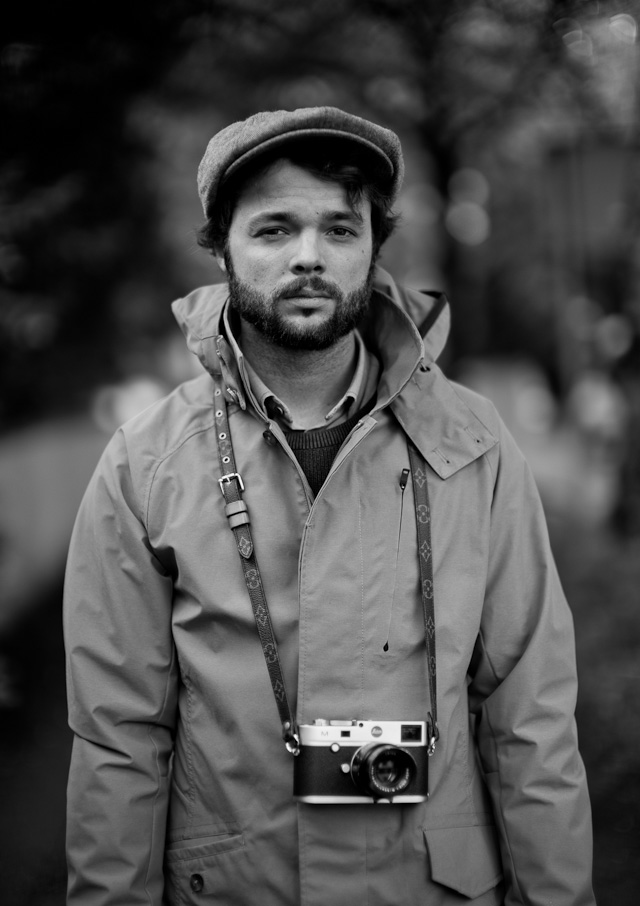
David Innerhofer from Austria at the Overgaard Workshop in Munich. 400 ISO. Leica M 246 Monochrom with Leica 50mm Noctilux-M ASPH f/0.95
It's not the camera that is going to make the photos, and not the lens either. It is your dedication and enthusiasm to use a camera and lens to make your vision come true that will bring about great pictures that you will be proud of.
Photography is not a test of your ability to get the best and most camera for the money. Yet most reviews are written as if the most important feature of a camera is that it has better numbers than the other.
It is not. The most important features of a camera is it's portability and it's owners love for using it.
When you buy a camera you shouldn't look at it as a monetary investment in features. You should look at it as an artistic investment: If it makes you an artist and communicator enough to produce photographs, you will be happy that you did.
The majority of people I meet have everything they could dream of. What they really dream of is to get less around them so they can see better.
Another camera I didn't need
I bought the Leica M Monochrom when it came out in 2012 and was enthusiastic about it for a while till I had taken somewhat 40,000 photos and then realized I was over it.
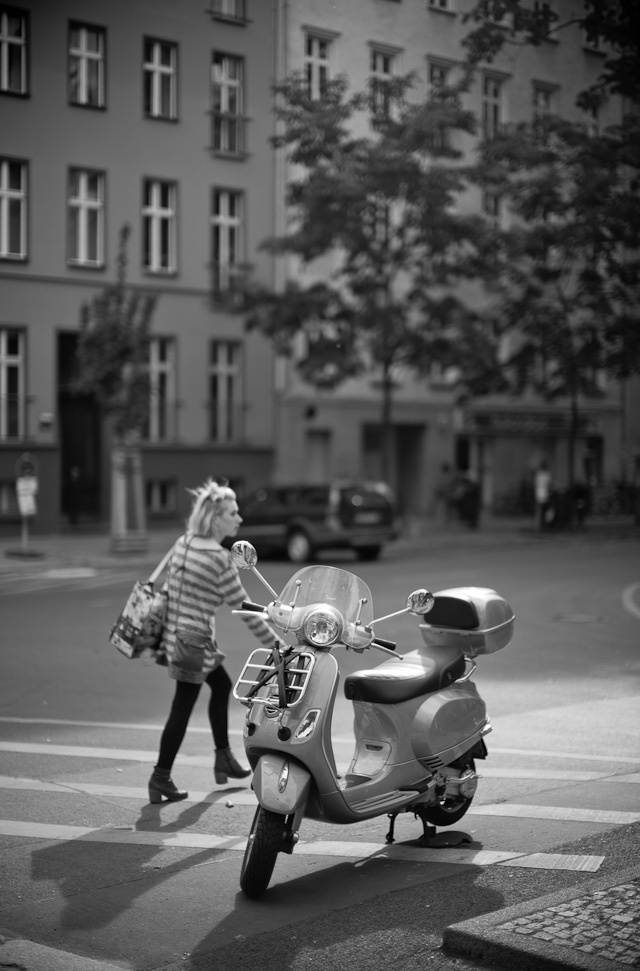
My daily Vespa in Berlin. 320 ISO. Leica M 246 Monochrom with Leica 50mm Noctilux-M ASPH f/0.95
I also realized that magazine clients would only print color photos. I had an ambition that I could make so great black & white photos that it would change things. And I did some with the MM as well as the M9 and M240 over the years that editors and art directors really loved. But they never printed the black & white version: They always ended up using the color version. I asked a magazine in Los Angeles why they didn't use the black & white photo I did in Nepal that they had spoken so highly about, and they said, "We have a policy that everything has to be color in the magazine".
That was my justification to get rid of it. My old assistant Tue Juelsbo wanted is just as badly as I wanted to get rid of it.
But now, here I am again.
Despite my certain feeling that the Leica M 246 wouldn't offer anything new I would need and most likely is a rather quick fix of the Leica M 240 made into a monochrom camera, I knew I would love to use it.
I bought one. For no particular reason.
Shame on you Leica Camera AG for making this camera and a nylon strap.
Don't try to stop me - Stop me! - from getting one of the first ones made.
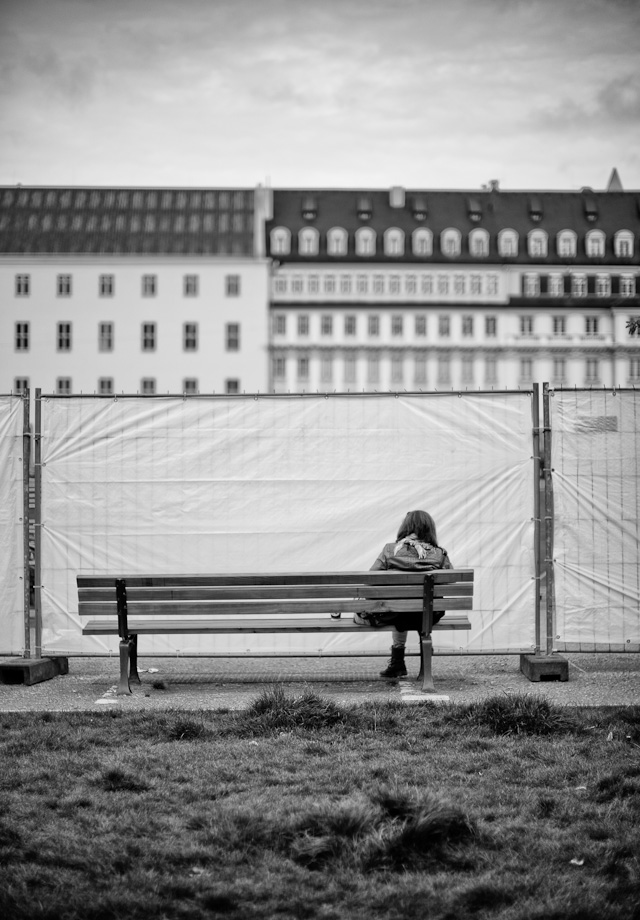
Waiting for something in Munich. 400 ISO. Leica M 246 Monochrom with Leica 50mm Noctilux-M ASPH f/0.95
Should I get the new Leica M 246..?
Yes and no. If you ask; probably yes.
There are many reasons not to get it: The Leica M Monochrom from 2012 is a great camera and offer the simplicity one would look for in a monochrom camera (Most likely you can find one second-hand, sold at a favourable price by someone who had to have the new Leica M 246).
The Leica M 246 doesn't offer much more than a little higher ISO. The Leica M 240 is capable of producing almost identical monochrom images and will get an update within the next 6-12 months to a new model of the camera that will likely offer higher speed of operation, higher ISO, more megapixels, more dynamic range and likely comes with both a bigger buffer (than the 2GB of the Leica M 246) and a version with a built-in EVF (Electronic Viewfinder) instead of the EVF-2 you have to mount into the hot shoe on top of the camera.
Not to forget, there is also the Leica MP that you can buy as a brand-new camera from Leica Camera AG - stunning slim classic film camera that will last for generations. If you like old school, the Leica MP might be the ultimate camera.
If you are still reading, probably yes.
You should get the Leica M 246.
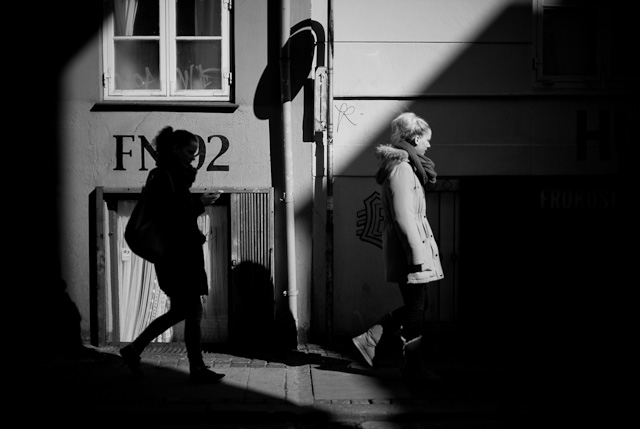
Shadowland. Copenhagen March 2013. Leica M Type 240 with 3200 ISO. Leica 50mm Noctilux-M ASPH f/0.95. Black and white converted from the DNG file via Lightroom using the 2010 Process. © 2013-2015 Thorsten Overgaard.
Comparing, comparing, comparing
I find comparing not to be applicable for me. I sold my old Leica M Monochrom to my assistant Tue for a very decent price. It's gone and I'm not going back. I got a new Leica M 246 and that's the one I want to use. I do the same with software. When I move on, I don't look back.
I simply don't care how the two compare.
If I take the Leica M Monochrom, the Leica M 240 and the Leica M 246 and go out on the street and take three different photos, what they will most likely show is that the light and the position of everything and everybody in that street changed between the three sample pictures.
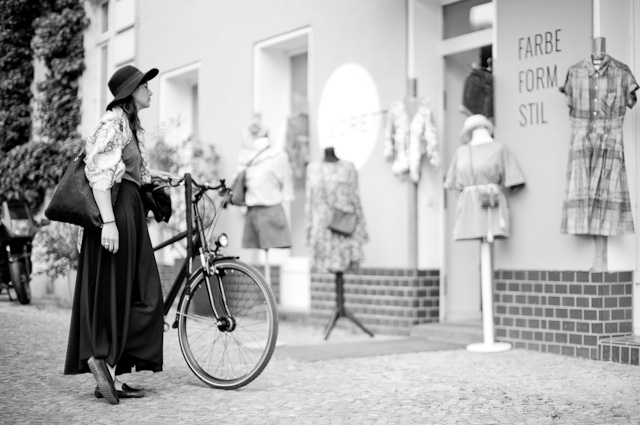
320 ISO. Leica M 246 Monochrom with Leica 50mm Noctilux-M ASPH f/0.95
So why would I care about the technical differences? I take pictures with the camera I have with me and I'm not walking back to the hotel to change to another one.
Some times the conditions are excellent and you make a great photo. If it's black and white, people will ask if it was done with the Leica M 246. No matter which camera. Not because the M 246 compare better to other cameras, but because the exterior conditions made a great photo possible.
If you want to compare ...
Realistically, why not compare computer screens? If a computer screen is not calibrated, the actual difference between what it is, and what it could be, most likely reduce the image quality of any camera to the model five years ago. And what is the difference in browsers, does Firefox show pictures better than Safari?
Some times you have to stop wondering and move on with what you decided for.
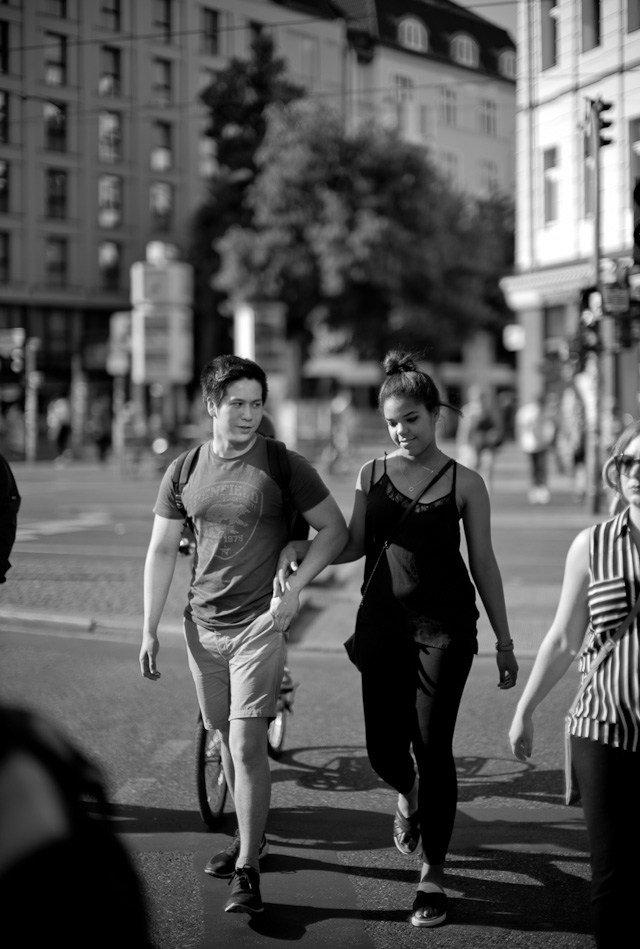
Young love in the morning sunshine at "Hipster Plaza" (Rosenthaler Platz) in Berlin Mitte.
320 ISO. Leica M 246 Monochrom with Leica 50mm Noctilux-M ASPH f/0.95
Comparison is relevant to a certain degree. I already decided long time ago that I was over the Monochrom. I shot more then 40,000 pictures with the Leica M Monochrom and … It’s was great camera but not practical to take out when magazines will not use the b&w photos but only color.
Photographing black & white make you see the colors and appreciate them. It reboots your skill to see colors and work with them. Just like shooting film make you see the advantages of shooting digital and helps you decide if you will go through the pain and cost of using film to get less possibilities of editing your images. For some it makes total sense and is the route to more decisive photography - simply because there is less to make decisions about.
Simplicity is a very valuable. Making a decision on what to use is a way to make things simple.

400 ISO. Leica M 246 Monochrom with Leica 50mm Noctilux-M ASPH f/0.95
Tonality of the Monochrom
The interesting thing to look at in the Leica M 246 is the tones. You can compare to other cameras, but what is more interesting is to compare it to what look you want. You may not know to begin with. First you have to find out what the camera can do, then you find your own look.
The Leica M Monochrom had (and still has if you have the camera) very nice skin tones, particular for darker skin. The new Leica M 246 has too, but I am still debating with myself if the red tones in both darker skin and in brighter (whiter) skin behave the way I want them to.
I will get much more into the tones and lack of tones in the Leica M 246 in my next article, "Leica M 246 goes to Paris".
Frankly, as it is right now, Adobe Lightroom doesn't offer the camera profile for Leica M 246 yet, so anything we analyze will change once we get the actual Leica M 246 Camera Raw profile (which was released with 6.05 on July 10, 2015).
It's always like that. When a new camera comes out, the profiles comes many months later. And Leica Camera AG might update the firmware as well to fine-tune it.
What am I going to do about that?
I am getting it to work with what I got.
Not as sharp as the MM
As I see the Leica M 246, it's not as ruthless sharp as the Leica M Monochrom. That is a good thing in my view because the MM was a problem wtih skin. Beautiful skin tones, but too much details.
Nobody wants to be photographed so their skin looks like a satellite photo of the moon surface.
It may be fun to blow up images and look at them in detail and be amazed of the details in them. But after a while when all your friends have left you, you realize that beauty in a face is more important than sharpness.
The Leica M 246 seems to bring back the balance between technology and beauty.
It isn't that elementary, is it?
I think one of the reasons it is hard to understand what the analysis of the Leica M 246 actually conclude (when reading this and other reviews) is that it doesn't add up. You move three years forward in technology, but it's hard to tell if technology actually improved in those three years.
It has been a hallmark for Leica products - lenses in particular - that new products are better than old products. In music many would agree that they made better products in the old days. The amplifiers had much more power. The strange thing is that when technology advances and should make it possible to make things better, they become less. That is the normal trend.
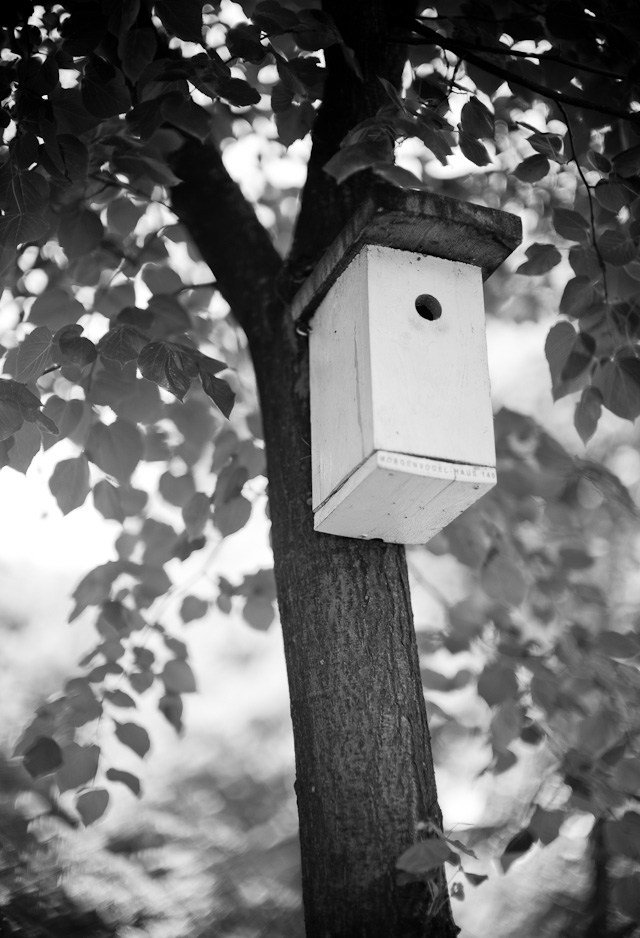 In Berlin the city provide housing for some of the birds in the city. Here it is Morgenvogel-Haus no 140 on Zionkirchstrasse, which is also to be found on Google Maps! ISO 320. Leica M 246 Monochrom with Leica 50mm Noctilux-M ASPH f/0.95 In Berlin the city provide housing for some of the birds in the city. Here it is Morgenvogel-Haus no 140 on Zionkirchstrasse, which is also to be found on Google Maps! ISO 320. Leica M 246 Monochrom with Leica 50mm Noctilux-M ASPH f/0.95
The industrialization has made it possible for everyone to go to H&M and buy new clothes for the price of a good meal, whereas in the old days, a new suit or dress was easily a months pay. It's easy to see that the H&M dress is not of the same quality as the one they made in the good old days. But times have changed so we actually don't care, because in six months we can go buy a new wardrobe, and it will have the extra advantage that it is in the new colors of the season!
A computer originally was for wealthy universities and governments and filled up a room, but today the power of the largest computers ever built back then fits on the arm wrist and even works on battery.
Leica lenses are one of the few products existing in today's world where new lenses apply technology that didn't exist before, and where that technology and precision is used to optimize the product to new heights. Nothing is spared and the result is lenses that surpass previous models.
The Leica M Monochrom M 246 seems to be a product that doesn't apply the knowledge and technology that is available. It applies a technology brought to market in September 2012 without much thought about what could ... well, anything.

Mick Jagger by Anton Corbijn.
Ansel Adams & Anton Corbijn
The Leica M8, Leica DMR and Leica M9 sensors were developed with the Kodachrome film as the ideal. "That is the last known standard we know that we liked", was what Leica Camera AG said.
In the Leica M Monochrom Typ 246 I feel an ideal is missing. And I mean an artistic and technological ideal, not a shareholder ideal. I think there was a rather strong idea and ideal for the Leica M Monochrom announced in 2012 where the mission was to "make a camera so people won't need black and white film anymore".
Maybe it would be a good idea to invest in a few Ansel Adams prints and hang them in the hallways of the Wetzlar factory where the people dealing with the next Monochrom walk every day. The Leica M Monochrom is not about what was done three years ago or what is done elsewhere in the world. It's about making stellar black & white photos.
What else would it be in a camera that doesn't have auto focus, color, WiFi, HDR or any other feature than monochrom tones?

Orvil Cox and Georgia O'Keeffe by Ansel Adams
The Leica M 246 is better than the Leica M Monochrom
The Leica M 246 may not be all what I had hoped for, but it is still the same jump forward from MM to M246 as the Leica M 240 was from the Leica M9.
I think that if one can work comfortably with the Leica M9 or Leica M Monochrom, that is great. Most people can't find rest and keep asking them self "should I get the new one?", and for me that is usually a sign that you have to move on to the new one. You are not comfortable with what you have.
Once you have tried the Leica M 246, you will appreciate the handling and speed. The sturdiness of the new-designed body, the higher ISO and the Live View with viewfinder. It may only be slightly better, but it is better, and from there there is no turning back.
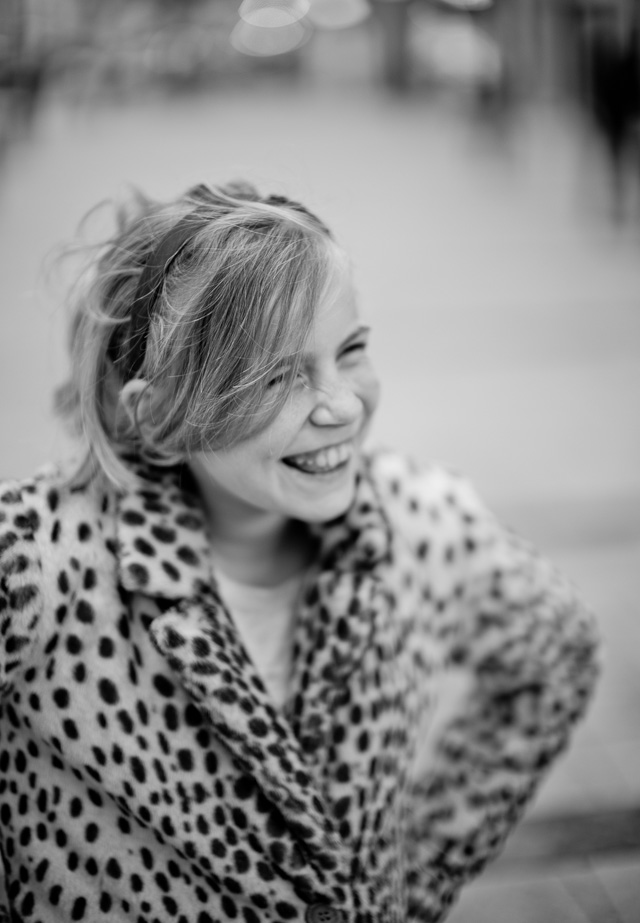
Robin Isabella von Overgaard. ISO 400. Leica M 246 Monochrom with Leica 50mm Noctilux-M ASPH f/0.95
The improved screen of the Leica M 246 (and the Leica M 240) is still not like seeing the image on a compute (and no camera ever will be), but it is so much better than the relatively raw and dark screen of the Leica M Monochrom and Leica M9.
The base ISO of the Leica M 246
Logically, the base ISO of the Leica M 246 should be 400 ISO, but is actually stated as 320 ISO. The Leica M Monochrom from 2012 had a base iso of 320 ISO as well but was based in the Leica M9 sensor with a base ISO of 160, minus the Bayer filter that gave one more stop of light when it was removed, hence 320 ISO.
As the Leica M 246 is based on the CMOS sensor of the Leica M 240 (that has a base ISO of 200), minus the Bayer filter, it too should be one stop faster: 400 ISO.
But according to Leica Camera AG, the base ISO is in fact 320 ISO.
I have used the Leica M 246 a lot on 400 ISO because I am a little stubborn and superstitious. I feel 400 ISO is the right base ISO. It feels more right.
A great thing about the Leica M 246 is that it doesn't go below 320 ISO. The Leica M Monochrom goes to 160 (PUSH) which will reduce the image quality and dynamic range with about 3 stops (which means you limit the range of dark and bright tones you can cover in one image).
Not having that choice in the Leica M 246 is great.
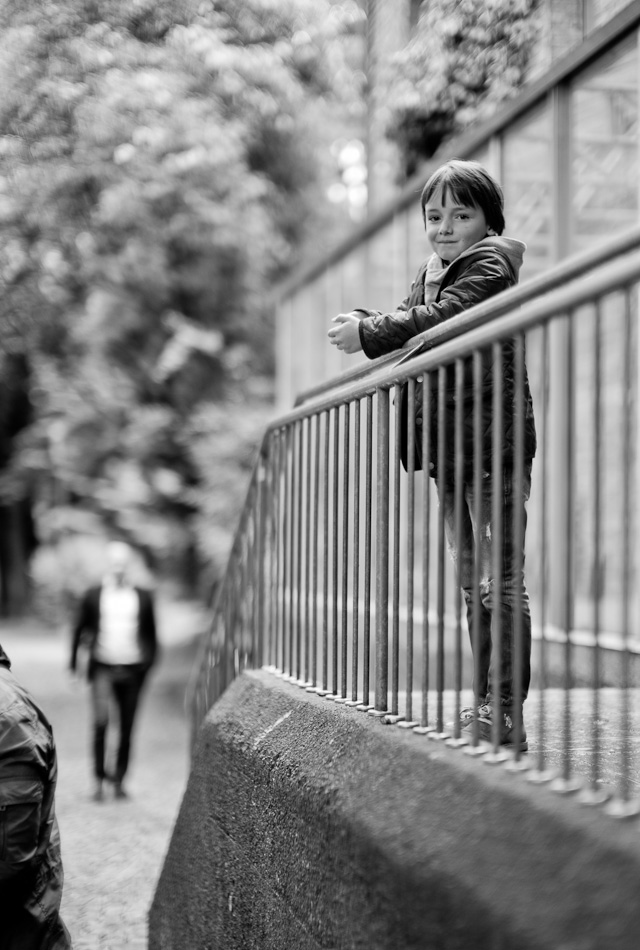
Outside the church in Residenzstrasse, Munich. ISO 400. Leica M 246 Monochrom with Leica 50mm Noctilux-M ASPH f/0.95
Need for ND filters
The high base ISO of the Leica M 246 makes ND filters necessary to be able to use the lenses wide open.
The maximum speed of the shutter is 1/4000 and if the ISO is 400, that requires that the lens is stopped down to 4.0 and some times 5.6 in sunshine. Some countries, and some seasons of the year, has stronger sunshine than others.
But even in overcast weather that looks relatively "gray", there can be almost as much light outdoor as if it was sunshine.
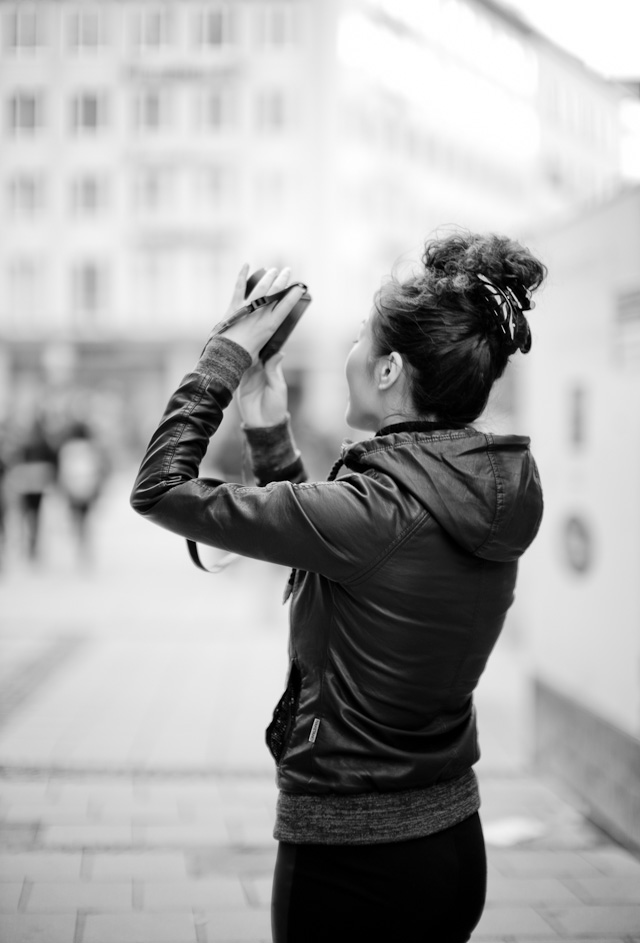 Tourist un Munich. ISO 400. Leica M 246 Monochrom with Leica 50mm Noctilux-M ASPH f/0.95 Tourist un Munich. ISO 400. Leica M 246 Monochrom with Leica 50mm Noctilux-M ASPH f/0.95
In my opinion one should be able to photograph with any Leica lens wide open, no matter the light conditions. In fact, for my own part, I almost always photograph all my lenses wide open. They are built for optimum quality wide open, and it's the look I like. A lot of my composition is based on the vision that there is a narrow focus and the story is isolated to a narrow, selective focus in the image.
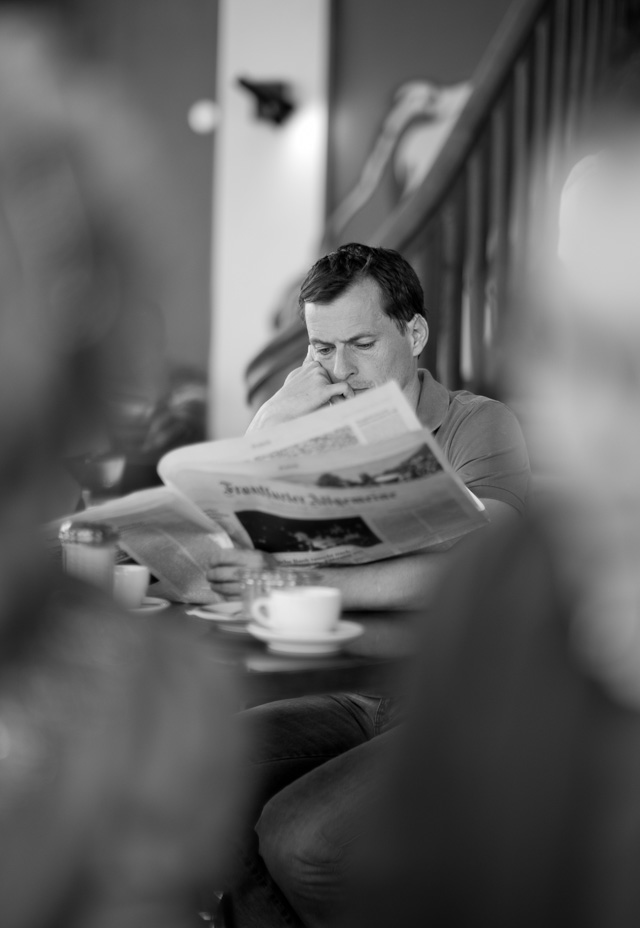
320 ISO. Leica M 246 Monochrom with Leica 50mm Noctilux-M ASPH f/0.95
The calculation for ND-filters is as follows: With a base ISO of 160 (on the Leica M9) or 200 ISO (as on the Leica M 240), you need a 3-stop ND filter for a Noctilux 0.95 lens.
I will usually get 3-stop for Summilux f/1.4 lenses as well, and they are easier to get hold of than 2-stop which could also be used.
For Summicron f/2.0 lenses I get 2-stop ND filters when I can, but will settle with 3-stop if I can't get 2-stop ND filters for them.
It is very easy to calculate the number of stops you need: You look at the lens and turn the aperture ring to f/2.8. That is the number of stops you need in the ND filter.

Advertisement:
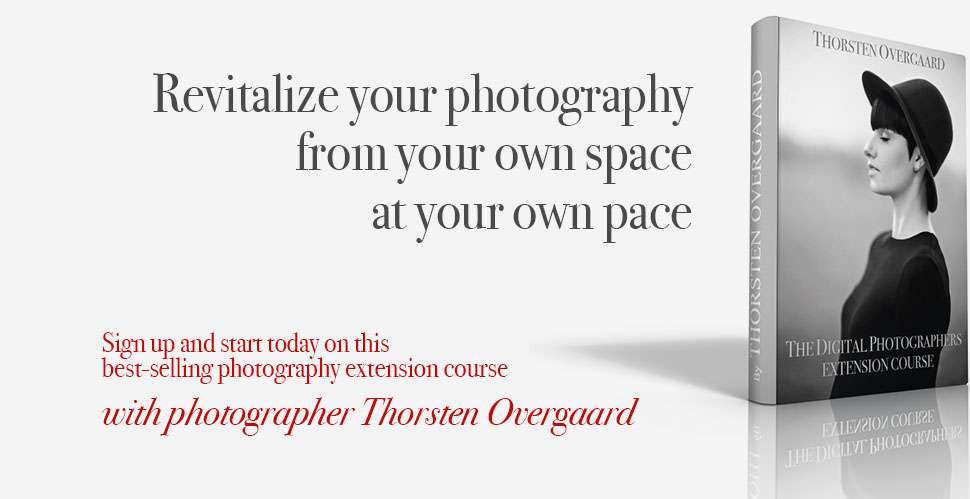

One more stop for the Leica M 246
The Leica M 246 changes this nice calculation with to one stop more because the base ISO of the Leica M 246 is 400 ISO (or 320 ISO if you like; and you cannot go lower). Now you need the lens to "go to f/4.0".
It's kind of surreal to to think about that we use a 400 ISO camera in sunshine. Not that many years ago that 400 ISO was for really low light. Now it's the lowest we can go. Maybe in the future the ISO will go so high in the top that Leica and others would reduce the base ISO of the sensor by the use of a ND-filter on the sensor itself.
Anyway, finding a 60mm ND-filter for the Noctilux 0.95 that is 4-stop is almost impossible (But Heliopan does make one). The 3-stops and 6-stops are easier to find.
Generally I never use the 6-stop ND filter I have for the Noctilux 0.95 because it may work in the sun, but when you photograph in the shadow it is simply too dark. Suddenly you find yourself at a shutter speed so slow you get motion blur.
On the Leica M 246 it's another story because you can easily compensate for the "extra two unnecessary stops" by simply going to ISO 1600 if you have to. It will work, and you won't be able to see it in the image.
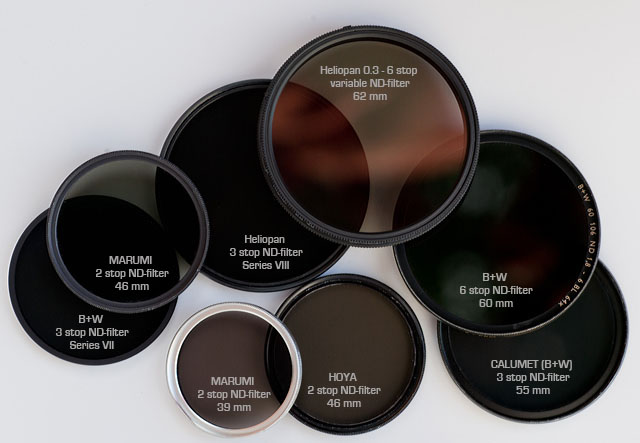
Some of my ND-filters for different lenses.
Another alternative is variable ND-filters as the ones B+W and Heliopan make. The variable ND-filter is basically two filters mounted as a sandwich, and when you rotate the one, it changes the amount of light that can pass through the filter. Hence you can change the density from a quarter of a stop (1/4 stop) stop to 6-8 stops.
I have both the B+W and the Heliopan but have gotten tired of using them. The B+W is not precise in the markings on the side and can turn all the way around. This results that the "ND-effect" occurs three times every time you turn the outer filter 360 degrees around around ... BUT ... only two of the three times it reduce the light as planned. The "third location" on the filter doesn't reduce the same way. Far from, actually. This makes it very confusing to use because the marking aren't precise, and if you look from the front of the lens to figure out how dark the filter is now, that too also doesn't make sense.
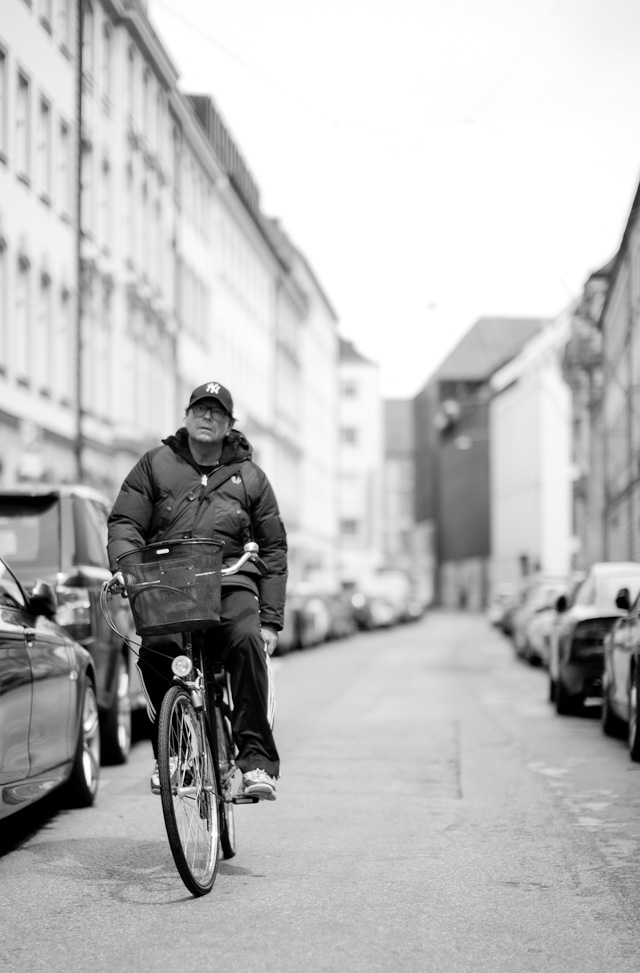
ISO 400. Leica M 246 Monochrom with Leica 50mm Noctilux-M ASPH f/0.95
I asked B+W about the markings on the side of the variable ND-filter they produce, and they said it was just an approximately guide. Decoration, in other words.
The Heliopan variable ND-filter is a heavier and more sturdy filter than the B+W and has markings that are fairly precise. When the mark is at 9 it means 3-stop and when it is at 12 it means 4-stop.
But here comes two other reasons to consider variable ND-filters and why I stopped using them: In some light conditions the two ND-filters in front of the lens acts as reflective mirrors. This result in soft contrast when you are shooting inside a building and towards a window, or under a roof in for example a train station or airport and there is relatively strong light coming from the background.
| Loss of contrast with variable ND filters against "strong" light source in low light: |
 |
|
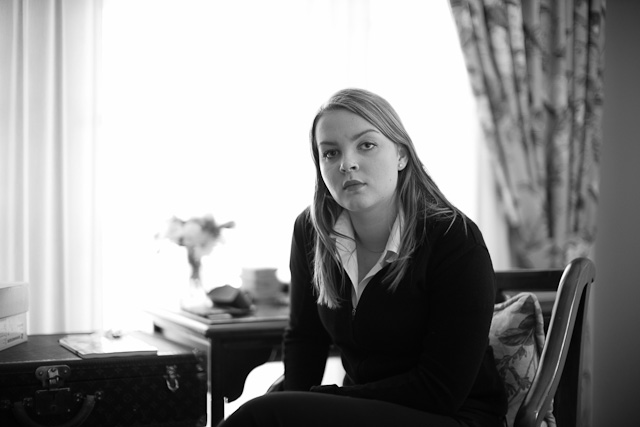 |
With the B+W Variable ND filter
f/0.95 at 800 ISO at 1/90 second
.
|
|
Without the B+W Variable ND filter
f/0.95 at 800 ISO at 1/45 second.
|
This is also the case some times with ordinary ND-filters (and UV-filters as well which I never use), but the effect is so much stronger when you have two parallel placed dark glass filters in front of the lens.
In sunshine I have tested the effect of ND-filters and I cannot see eny decrease of contrast from the ND filter. It works fine. It's only in shadow and dark locations with a relatively strong light source behind the subject that is affects the contrast.
Another reason to go back to simple (one layer of glass) ND-filters is that they are simple. Easy to have in a pocket, easy to mount, always the same ND-value (doesn't turn around).
That said, I have had a lot of good results using variable ND-filters, and in the case of the Leica M 246 they solve that exact problem of the need to reduce the light 4 stops in sunshine and nothing in shadow.
If you use a variable ND filter all the time, you will get used to them and it works. I just got tired of the unintelligent design of them and lusted for some simplicity in my life (if you feel an article coming up dealing with ND filters and their "approximate values" selling for $300, you are right).
Shading Correction
A new thing in the Leica M 246 menu that we haven't seen in other cameras is the Shading Correction in the MENU.
This is a function that simply removes the dark corners that may eventual occur with some lenses. The correction is done by identifying the lens profile of the lens.
The Leica M series lenses have a 6-bit code engraved on the bayonet, and older lenses can have them engraved by Leica Camera AG. This 6-bit code tells the camera which lens is attached, and where the Leica M 240 uses this information to correct colors and corner shade, the Leica M 246 obviously only correct the corners.
I have started out with my Shading Correction set to Off because I generally believe a lens design is as it is and I don't believe in software corrections. I was never bothered by dark corners, so why start now?
| Shading Correction Off: |
|
Shading Correction On: |
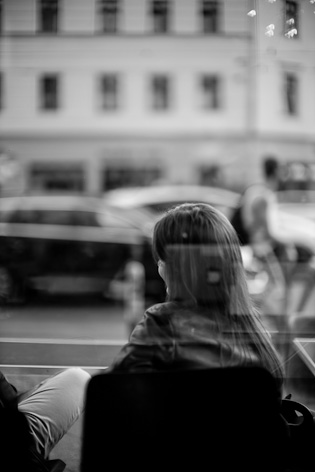 |
|
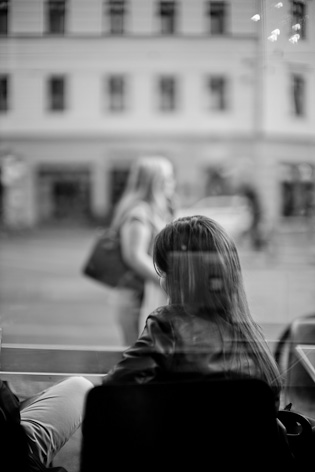 |
| Generally there will not be much difference between Shading Correction On or Off, but having it On will clean out eventual dark corners. |
Learning a new camera
I found myself photographing patterns the first morning I used the new Leica M 246 at the Overgaard Workshop in Munich. It's somehow very natural to explore patterns and textures with the Leica M 246. I think it is one of the advantages of getting a monochrom camera; that you start look in a different way. After lunch I decided I needed to go look for some people to put into my photos. I didn't feel quite myself with all those textues.
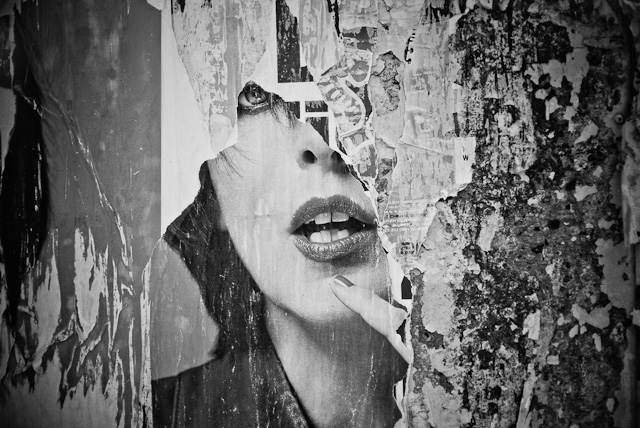
Leica M 246 Monochrom with Leica 50mm Noctilux-M ASPH f/0.95
As a side note, the Ralph Gibson's book MONO which is a mix of nudes and texture is very good to get inspired from. To do a book with nudes mixed in-between photographs that explore textures may not seem that logical. In fact, at a very early stage of his career, Ralph Gibson decided to curate his own things and publish his own books. And thank God for that!
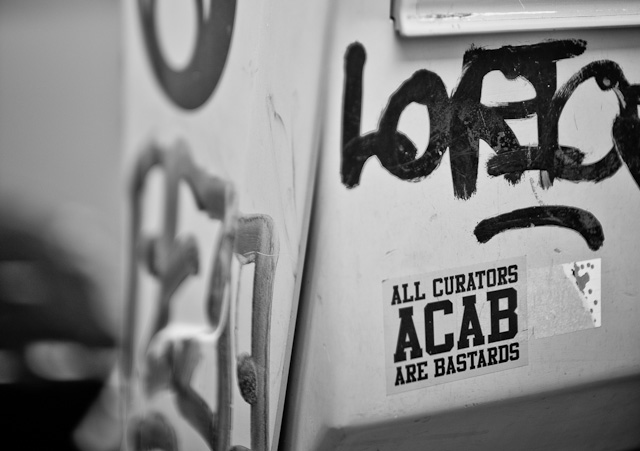
All Curators are Bastards. Leica M 246 Monochrom with Leica 50mm Noctilux-M ASPH f/0.95
The emotional impact of reading MONO is very interesting: The mix of textures and nudes makes total sense. Somehow the MONO book is a training in increasing ones sensibility for shapes, patterns, light and shadow. You sense and feel the aesthetics, but you probably can't express with words what it is. But you may see it.
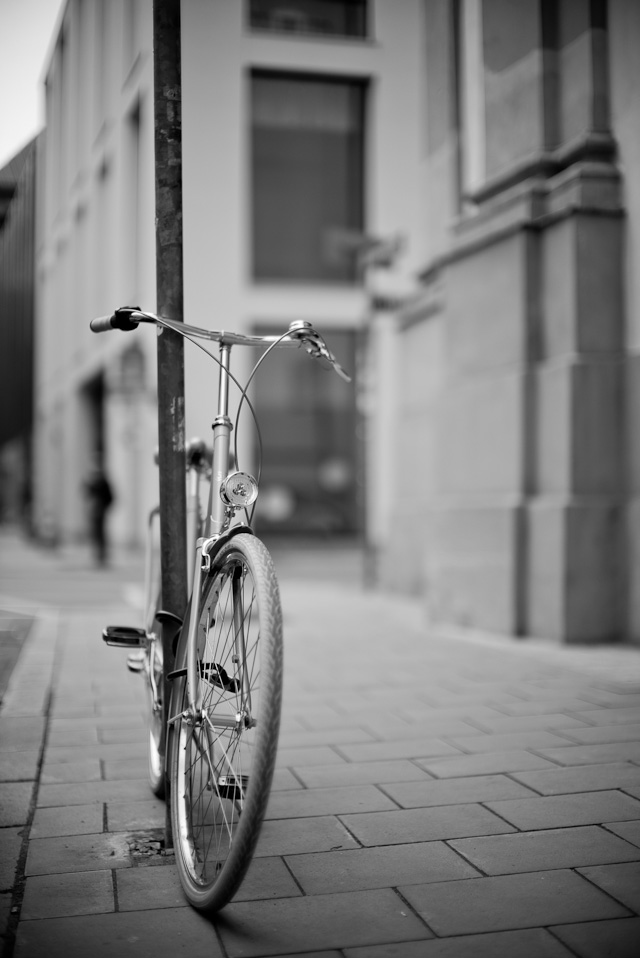
400 ISO. Leica M 246 Monochrom with Leica 50mm Noctilux-M ASPH f/0.95
Sell us cameras with no grain - so we can add them ourself
Plenty of pixel-peeping is going on online and elsewhere to study and compare the the noise level of the Leica M Monochrom with the Leica M Monochrom Typ 246. Erwin Puts excellent articles on grain of the two cameras is showing 40 times magnifications of the test charts.
While interesting on some level, it is hardly applicable for daily use. In fact, I know users of the Leica M Monochrom who add 30% grain in Lightroom so as to make it less perfect.
(Here, by the way is an article from Leicaphilia, "The Renaissance of Film Grain in the Digital Age" to make you think about grains and noise).
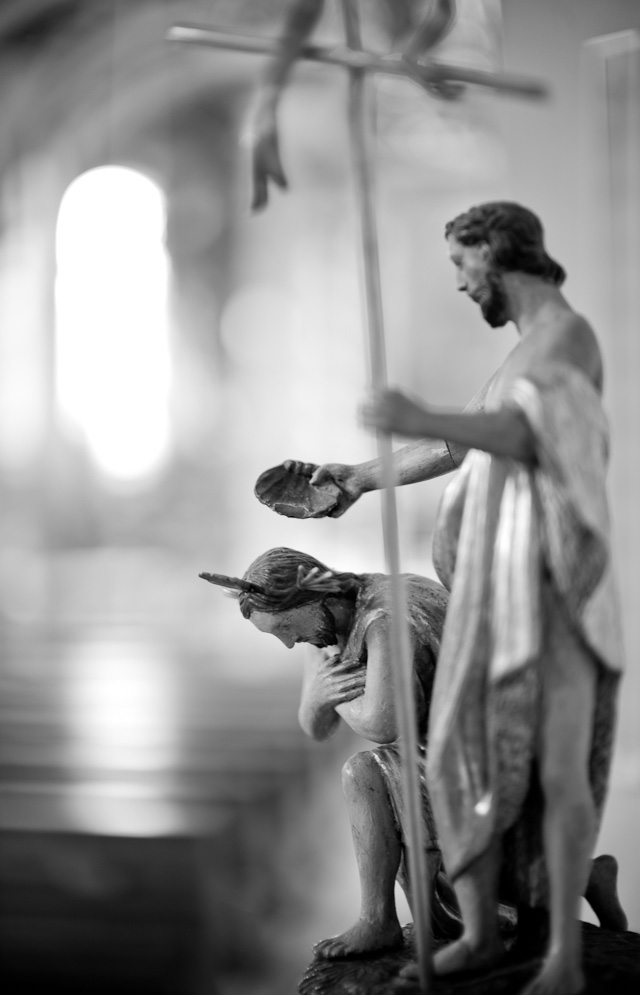
400 ISO. Leica M 246 Monochrom with Leica 50mm Noctilux-M ASPH f/0.95
But perhaps more entertaining is the fact that somewhat 50% of Leica M Monochrom users apply grain to their images in using Silver Efex Pro 2. This is where you can apply film look to the digital file, as well as effect filters.
If nobody else will say it, I will: We are beyond the point where grain or noise is a visible problem.
What is more relevant is the quality of the tones (and colors for those cameras that record images in colors), and how the colors of a subject are translated into monochrom ... and mainly if the look of the tones is consistent throughout the ISO scale.
Remember that any sensor in any digital camera has a base ISO, and that is the only ISO it has. The rest is computer algorithms calculating how the tonality will be if there is eight ot sixtyfour times more light.
In the Leica M Monochrom and the Leica M 246 the base ISO is 320. In the Leica M 240 the base ISO of the sensor is 200. In Leica M9 the base ISO is 160. In most Canon cameras the base ISO is 100 ISO, and in most Nikon cameras the base ISO is 200.
The sensor simply doesn't see more than that. The rest is computer algorithms.

Harri Kulju from Finland found a rare Opel Kadet during the Overgaard Workshop in Berlin. 320 ISO. Leica M 246 Monochrom with Leica 50mm Noctilux-M ASPH f/0.95
In the old days it was actual chemistry, and a 3200 ISO film has actual light-sensitive chemistry that was so sensitive it would records an image in very low light.
Leica Camera AG have wisely decided to use the term PUSH for the range of the ISO that is beyond or below what can be considered consistent quality. PUSH refers to when we used film: When you bought a 200 ISO film but exposed it as a 800 ISO film because there was less light than you needed, you would tell the lab to PUSH the film two stops so the chemistry artificially became 4 times as sensitive (two stops is 4X light). This resulted in less control of colors and tones, as well as larger grains.
In the Leica M 246 Leica Camera AG has rightfully put the ISO scale from 320 to 12,500, and added 25,000 PUSH.
In the image series below one can see that the image quality is quite consistent from 400 to 12,500 ISO and only the 25,000 ISO image seem to suffer from lack of control of tonality.
| Leica M 246 at 25,000 ISO: |
|
Leica M 246 at 12,500 ISO: |
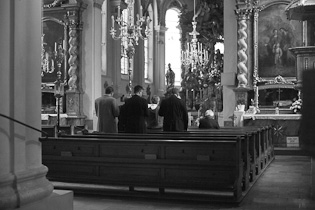 |
|
 |
| |
|
|
| Leica M 246 at 6,400 ISO: |
|
Leica M 246 at 3200 ISO: |
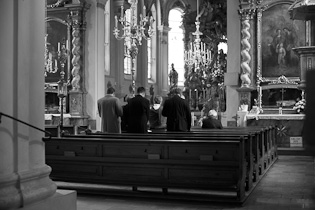 |
|
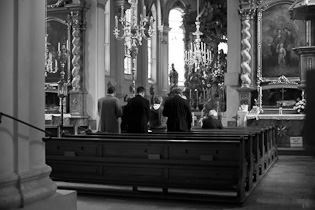 |
| |
|
|
| Leica M 246 at 1600 ISO: |
|
Leica M 246 at 800 ISO: |
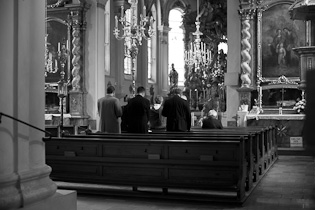 |
|
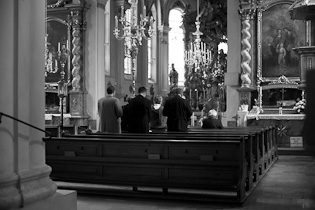 |
| |
|
|
| Leica M 246 at 400 ISO: |
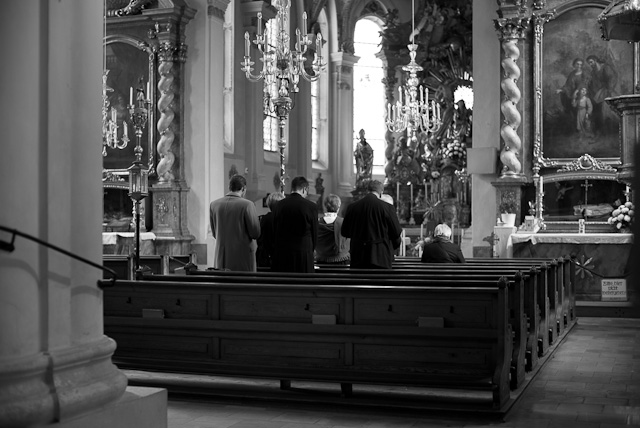 |
| Church choir in Munich. Leica M 246 Monochrom with Leica 50mm Noctilux-M ASPH f/0.95 @ f/4.0 |
| |
| Leica M 246 at 400 ISO with Agfa APX Pro 100 ISO filter in Silver Efex Pro 2: |
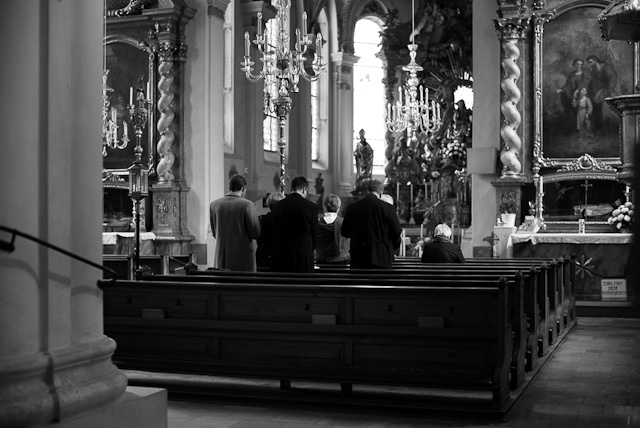 |
| |
| Leica M 246 at 400 ISO with High Structure (Harsh) filter in Silver Efex Pro 2: |
 |
It's no art photographing high ISO in daylight. The problem is to shoot high ISO when there is no light. And when else would you need high ISO?
That is why the actual quality of your images with the Leica M 246 (and any camera) will show when you find yourself in conditions where you need to use 12,500 or 25,000 ISO.
"Need" is an interesting word to use about 25,000 ISO, considering Leica provide low-light lenses that capture perfect images at f/0.95 and f/1.4 and photographers in the past managed to make night photographs at 10 ISO with f/3.5 lenses.
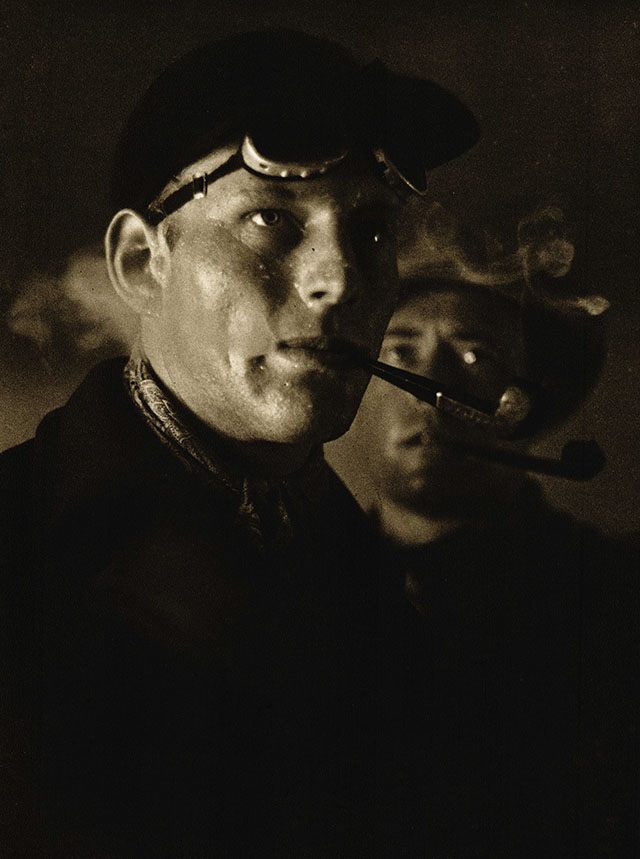
Dr. Paul Wolff with Leica 50mm Summar f/2.5, 10 ISO, 1/20 second. From the book "Meine Erfahrungen Mit Der Leica" (1939).
Here are some low light photos from Berlin of the radio tower. The 25,000 ISO (PUSH) is all right, but the tonal range and contrast suffer compared to the 12,500 ISO to the right. As it is expected when you PUSH the ISO.
The second row shows how 6400 ISO and 12,500 ISO are very much the same.
The conclusion is easy: 12,500 is the maximum ISO where you can maintain the same tonal range and contrast as with 6400 and lower ISO. Simply put, the Leica M 246 is safe to use from 320 ISO to 12,500 ISO.
| Leica M 246 at 25,000 ISO (1/250 sec): |
|
Leica M 246 at 12,500 ISO (1/125) sec: |
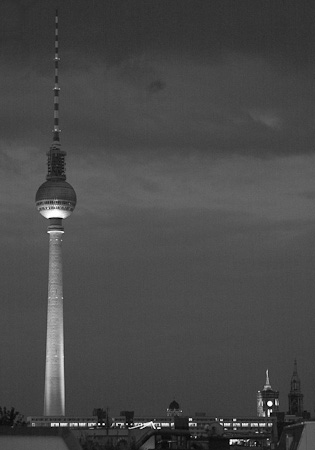 |
|
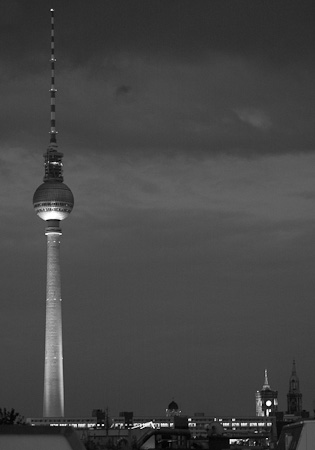 |
| |
|
|
So far, so good. Let's see how 6,400 (left) and 12,500 ISO (right) compare:
|
| Leica M 246 at 6,400 ISO (1/60 sec): |
|
Leica M 246 at 12,500 ISO (1/125) sec: |
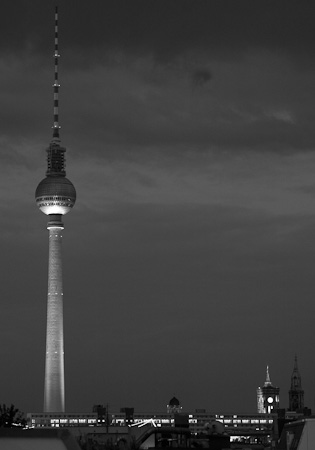 |
|
 |
In most cases I think I would stay at 6400 ISO. Why is that? Because I want to maintain control of banding and tonality and grain overall.
Below I have put three images together. The 25,000 ISO image file has some banding. It may work in many cases, but the less light, the harder the sensor is working to see in the dark and will offer noise when it lacks data as to what is there. Some colors and/or light sources may cause more banding than others (LED, enery-saving bulbs, etc).
At 12,500 ISO it is decent, and at 6400 ISO the file is clean and nice.
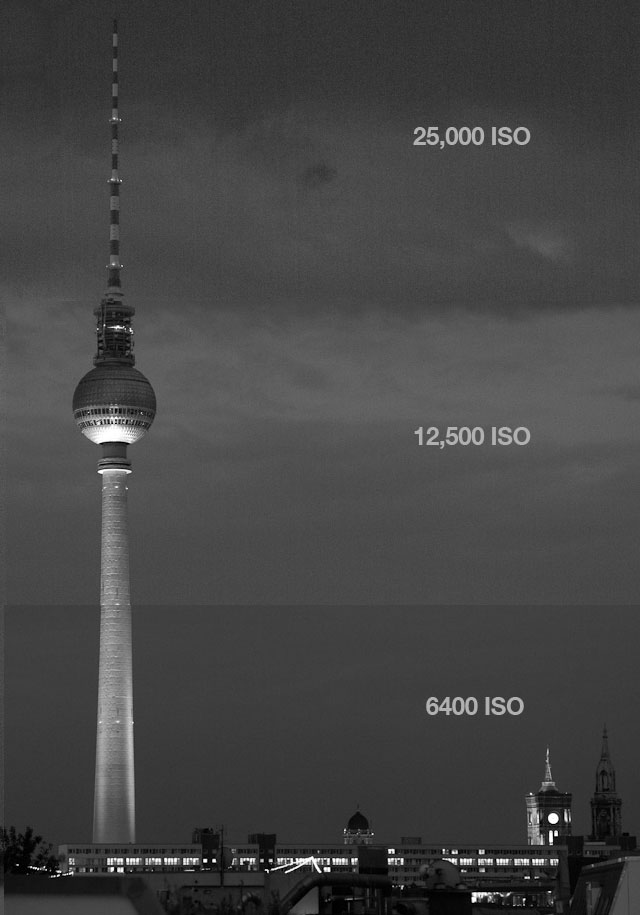
Three images stitched together with each their ISO. Leica M 246 Monochrom with Leica 90mm APO-Summicron- M ASPH f/2.0.
 |
NEW VERSION 11.3 |
 |
| |
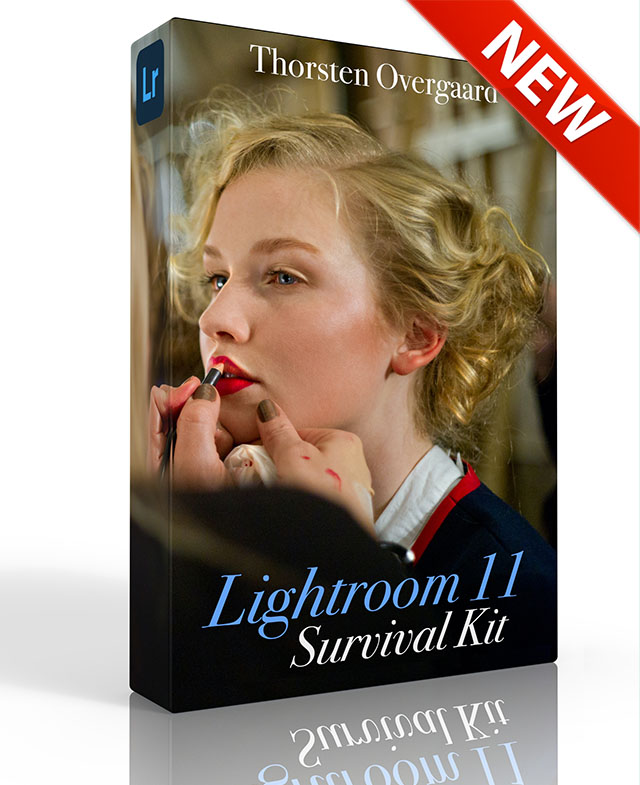 |
|
| |
|
| |
|
|
|
|
| |
|
| |
|
|
| |
Buy Now. Instant delivery.
New Version 11.3
ONLY $698.00

Now includes
4+ hours of
video tutorials.
100% satisfaction
or 100% refund.
More info.
|
|
| |
#2130-1121-3 |
|
| |
|
|
| |
Update to Version 11.3
Apply
code "UPDATE113" on checkout to get this complete version 11.3 update.
$298.00

Updates all previous Surival Kit versions since 2009. |
|
| |
|
|
Buy the complete new
Lightroom Survival Kit 11.3
The Legendary Tutorial for Photographers
Brand-new JUNE 2022-version.
Now with brand-new 4+ hours of video tutorials.
New sections on compostition and storytelling.
How to edit color photos.
How to edit black & white photos.
How to do keywords logical and easy.
The most successful photo editing kit ever
Photographer Thorsten Overgaard first released the Lightroom Survival Kit in 2009 and have honed it with new and fresh updates. This Version 11 is the most radical updated and renewed version ever, four years in the making.
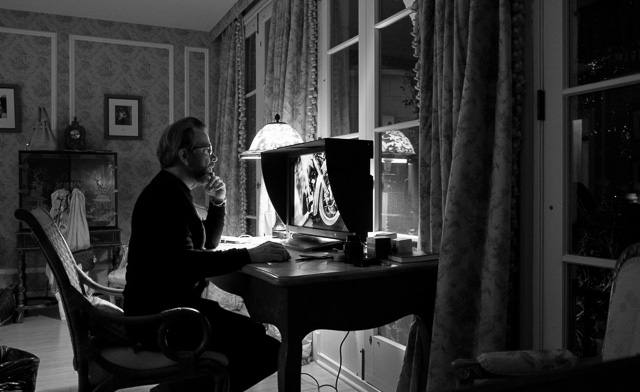
Professional workflow experience made simple, logical and easy to use.
Master editor makes it simple to understand
The Survival Kit is unique and one-of-a-kind being made for photographers for photographers. When someone understands their subject, they can explain it so it is easy to understand. The hallmark of Thorsten Overgaard is to make expert knowledge shown and told in a way so anyone can apply it.
Hands-on advice that works
With a 450 pages workbook and 4+ hours of video, every element of digital photography is touched on, in handy chapters and pre-flight checklists. Editing of color vs black and white photos, keywording, cropping of images, fine-tuning of tones, color balance and color control, export of originals, printing, archiving and backup, and much more.
Comes with the Overgaard Leica Presets (Value $48)
The Lightroom Survival Kit comes with Thorsten Overgaard's special-made Lightroom Presets for all digital cameras and for Leica digital cameras.
Understand all from camera to the final print
Chapters in this version goes over the background for High Dynamic Range (HDR), digital raw files and how to set up a professional photography workflow, from calibrating the screen to editing in Lightroom, and to making a final print. And more ...
10+ years experience in one package
No need to spend years figuring out the smartest way to do things when you can tap into the best way of doing things right here. The workflow of Thorsten Overgaard as been refined through years of field work with more than a thousand workshop attendees.
This method of workflow now used by thousands
The Survival Kit has been taught to thousands in workshops and in this Survival Kit. What does it do? It make you enjoy taking and making photos, and it increases your production considerabely. Most important of all, it'll give you back ownership of your files (which you will understand why is so important, once you have bought the Survival Kit and started applying its methods).
| |
|
|
| |
"Thorsten's methodology is perhaps not what hardware-, software- and cloud-companies want us to do, but as a former IT engineer I can only acknowledge his views about preserving our digital heritage. This workflow explained is for me the best I have ever seen".
★★★★★ |
|
| |
|
|
Video tutorials, image files, presets, checklists, definitions, tutorials of Lightroom, that boils down years of experience to a workflow you can implement in less than one day.
Start working in minutes. |
|
|
| |
|
| |
|
| |
|
| |
|
| |
|
| |
|
|
|
|
 |
|
 |
Win a Leica M 246 Monochrom
In the quarterly I-SHOT-IT.COM Black & White Photography Competition you may win the first prize which is a Leica M 246 and a cash prize. Judged by Birgit Krippner and Thorsten Overgaard.

Sensor noise and remapping
Generally, when you push a sensor to over-perform itself, you get banding which is horizontal lines in a horizontal pictures (if the camera is in portrait mode/vertical, the lines will be obviously be vertical). It's simply noise; the result of uncontrolled algorithms working overtime with an image the sensor really can't see because it's very dark.
If you have a sensor with 400 ISO, that is what it can see, and now you ask it to use night-vision that is 6 stops more than it can actually see. 6 stops above 400 ISO is 25,000 ISO and require the sensor to see 64 times better than it actually does. Each stop on the lens' aperture reduce the light to half, and each step up in ISO increase the light sensitivity to the double (6 stops is 2x2x2x2x2x2 = 64).
For the fun of it, try to take a 64X ND-filter and look through it. You can hardly see anything.Now you know what it is you are asking your sensor. Have some compassion!
Now, if your image have vertical lines in it, it is more likely that the sensor needs remapping. Leica Camera AG simply needs to reset the sensor and lay out the pixels again. It's a fairly fast thing to do, once the camera is in the hands of Customer Service in Wetzlar. As far as I know, electronics, flying and other disturbance can cause this. It's usually not a quality control issue from the factory but something that happened to the sensor during use. Ask Leica Customer service what to do if you have vertical lines in your image.
It is not a thing that happen a lot, and when it does, it some times disappear by itself. I fly quite a bit and only had vertical lines once in a Leica M9 in the beginning, right after I unpacked it; and after a few thousand photos I never saw it again.
The point is: If you have horizontal lines, you stressed the sensor. Go down in ISO.
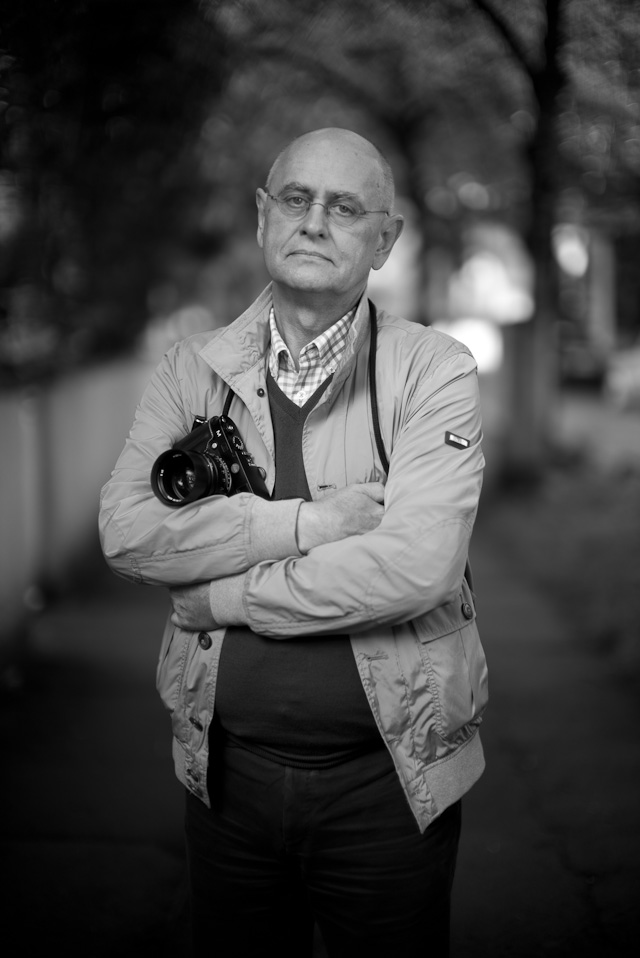
Helmut Klein is not unhappy with the tonality of this picture (how could he be?). I think he is looking at my yellow camera strap and wondering how to top that. 400 ISO. Leica M 246 Monochrom with Leica 50mm Noctilux-M ASPH f/0.95
The well tempered shutter
The Leica M 246 shoots a little more than three images per second where the Leica M Monochrom shoot two frames per second. On top of that the whole shutter mechanism and body has been redesigned so the Leica M body now is one piece of metal (except a plate slit in into the front holding the M bayonet mount). It is a very sturdy camera body with very tight high-precision assembling, including weather sealing.
All in all the faster shoot rate and new design of the mechanism result in a very determined sound that almost sounds like a small guillotine. The sound is more metallic in the beginning. After some weeks with a good handful of actuations the shutter sound will be softer and more relaxed, yet still very determined and short.
Where the initial sound is a bit embarrassing, like a Death Star laser, the sound of the well-used shutter is well tempered and ... addictive.
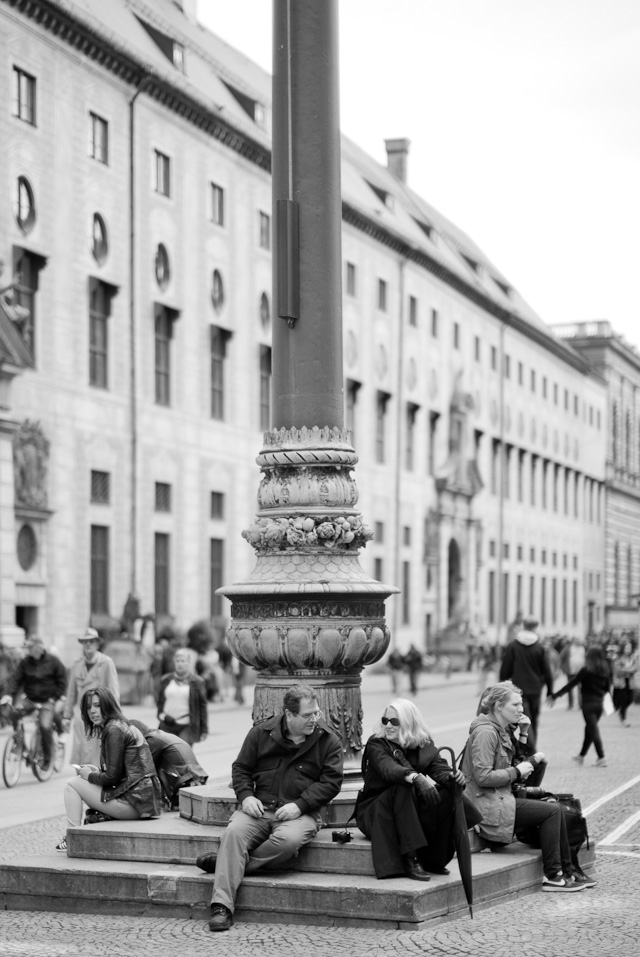
Odenonsplatz in Munich. 400 ISO. Leica M 246 Monochrom with Leica 50mm Noctilux-M ASPH f/0.95.
A new design of the same camera body
You will oddly enough feel how well built it is from the first moment. It is not that the Leica M Monochrom was not built to last more or less for generations. It is. The Leica M Type 246 is just built even better. More precision in everything, and a redesigned body that is made out of one piece so there is no assembling in the bottom of the camera. It's quite a piece of work.
Getting used to the Leica M Type 246 when coming from 6 - 12 frames per second
If one are used to cameras with very high frame rates, one may have developed a shooting style of shooting a series of 6-12-18 frames per pose or simply always end up with 6 frames every time one press the shutter. That is overkill but will work if one works fast in editing and concentrate on looking for the few good photos (and omit comparing what is duplicates). But it is killing the model. High frame rates are for action photo, not landscape and model shoots.
When coming from high frame rates to the more moderate Leica M Type 246 you will have to get used to look at the subject and stop listening to the frames per second. It takes one click to get a photo, not 10 clicks.
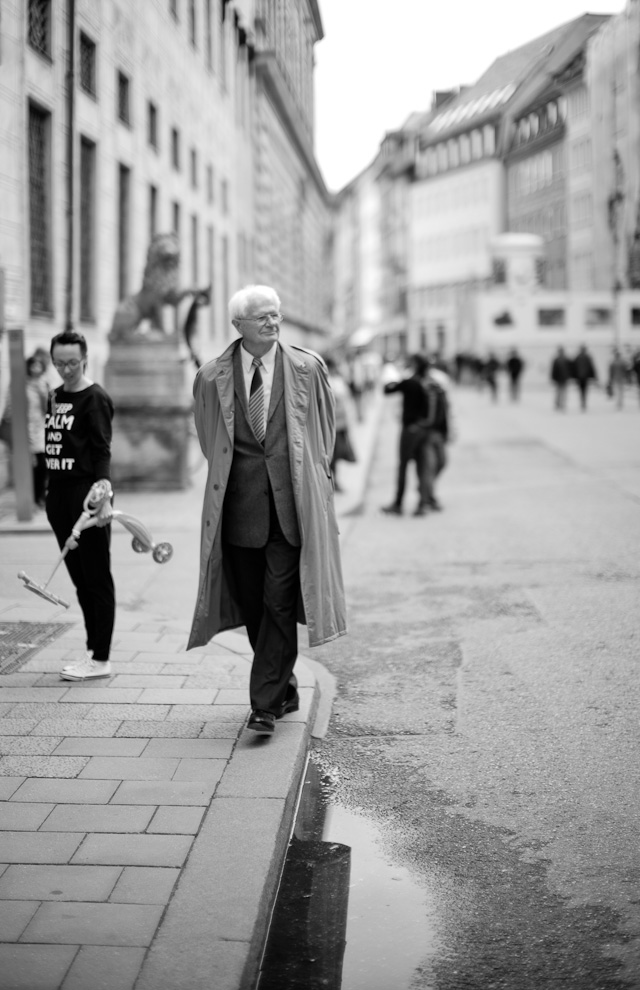
Sunday in Munich. 400 ISO. Leica M 246 Monochrom with Leica 50mm Noctilux-M ASPH f/0.95.
How to deal with the Leica M Type 246
For those who come from the Leica M Monochrom, my advice is to start out with the Leica M 246 as if it was a new Leica MM. Don't add anything new but simply use the analog rangefinder mechanism as always and learn the new menus and the different sounds and feel of the camera.
The preview button top left of the display on the back is now a LV button (Live View, which open up the shutter curtain and shows a live image on the preview screen). That takes some days to get used to not using when you want to see a preview of an image.
I am fairly certain you won't follow this advice but want to try out Live View, video and everything else as soon as possible. And you will try to avoid studying the menus and you will try to tell yourself you really don't need to read the manual to use it.
So let me just warn you that all these new things in a camera that used to be relatively simple will make you feel a little stupid and tired. The good thing though, is that you will get the feel of it after some weeks, and then it all will become muscle memory.
If you want to speed up the learning progress, read the manual and put the manual on an iPad or iPhone, take the camera out to some quiet location where you can do the same shots again and again, study the behaviour and refer to the manual when needed.
In the bottom of this page is the basic standard settings of the camera I recommend. Start with those so you can concentrate on one new thing at the time.
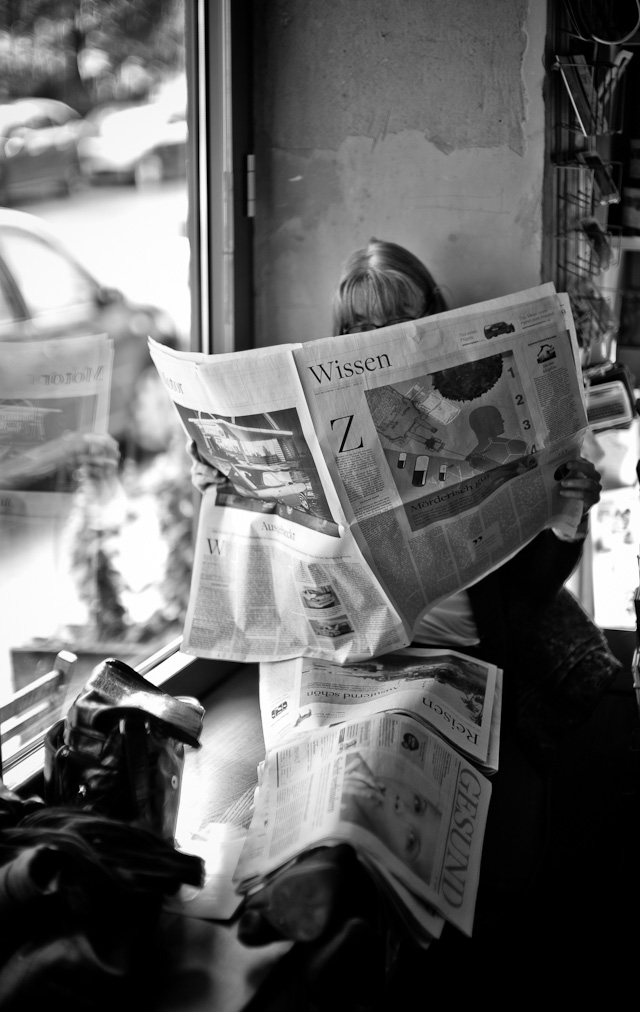
News coverage to keep you warm and up to date with the propaganda. ISO 400. Leica M 246 Monochrom with Leica 50mm Noctilux-M ASPH f/0.95. Edited in Lightroom using "2010 Process" and the "Mauri Muted SHARP" preset that comes with the Overgaard Lightroom Survival Kit 6.
Importing Monochrom (Typ 246) files to Apple Photos App
Since the launch of the Leica M Monochrom and until the Apple Yosemite version 10.10.4 (released end of June 2015) there has been a problem importing M246 files into the Photos App. The App would crash and/or corrupt the Photos library.
Photos (or iPhoto) is not the right application for Leica M 246 files in my opinion, but should you have used it, corrupt files from previous to version 10.10.4 from Apple's should be recoverable. So contact Apple or Leica if you have this issue. But wait till you get 10.10.4 and see if you have a problem after that.
Don't blame Leica or Apple for the fact that you bought a state of the art camera and decided to manage your image fiies with a tool made for teenagers.
The reason Photos is not the proper tool for image storage and editing is that you must organize your own archive and not rely on a software to do it, and the Photos App works with hires files and copy new versions every time you move them. It's a mess and just gets worse the more you use it. See my Lightroom Survival Kit for more on workflow and how to organize your digital life.
A note on Apple iPhoto and Apple Photos App
When you install Photos, it will open you iPhoto archive and convert it into Photos archive.
When you look in your Picture folder on the Mac later, you will notice that you now have both a iPhoto Library and a Photos Library.
Apple don't delete the iPhoto Library after you converted it, so your images are now double the space. You can basically delete the iPhoto Library now (you cannot open it anyway; though you can ALT+CLICK the iPhoto Library "shell" folder and see the content and that way see and take out the image from an old iPhoto archive).
The same might be the case if you installed Photos App onto a machine where you previously used Aperture.
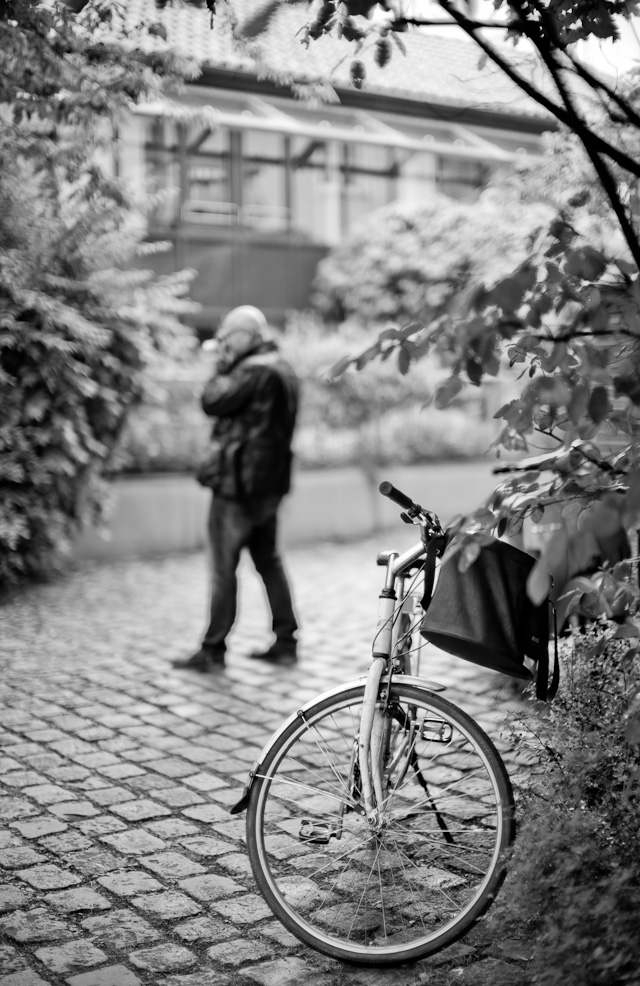
Michael Bassier out and about with the Leica at the Overgaard Workshop in Munich. ISO 400. Leica M 246 Monochrom with Leica 50mm Noctilux-M ASPH f/0.95
Compressed DNG or Uncompressed DNG?
DNG stands for Digital Negative.
I recommend shooting Compressed DNG as this is lossless*. This basically means that when you shoot an image, the image contain a lot of 'empty' information, and compressing the DNG image simply is not storing the empty fields of information. This is how the size of the file is reduced to half.
The discussion of compressed is ongoing. Will future technology be able to make information out of 'empty' fields? I don't believe there is any information in the empty fields, so I decided to shoot compressed/lossless. And if there were information in the 'empty' fields, my policy is to finalize photos today to final editions, not to re-open old photograph to re-edit them later. The photos of 1970 looks like 1970, the photos of 2015 looks like 2015.
If you are unsure, set the Leica M 246 to Uncompressed. It will take twice the space and make the camera writing to the card slightly slower, and working in Lightroom will be slower due to the more data. But it is not the end of the world.
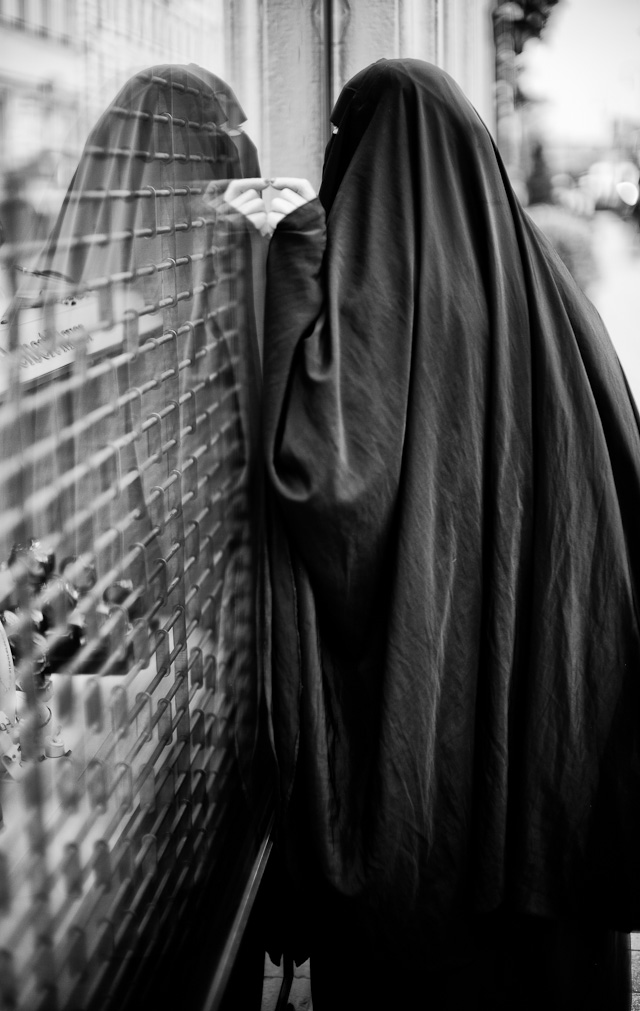
Buying stuff. ISO 400. Leica M 246 Monochrom with Leica 50mm Noctilux-M ASPH f/0.95
Lossless*
Lossless compression basically is when you can compress something and later 'unpack' it or somehow get it back to it's original form. Like compressing a zip file that will turn back to it's original form when unzipped. As the Leica M9 and Leica MM Compressed file can never be brought back to it's original form, it is not really lossless. What you removed, you lost. You may never need it, but you can't get it back in any case.
The Leica M 240 and Leica M 246 is different, Leica Camera AG states, thought currently I do not understand the concept exactly of how it is now lossless. I still don't see how I would get a UNcompressed file out of a compressed.
Advertisement:

What is DNG..?
DNG stands for Digital Negative and is an open lossless raw image format developed by Adobe.
RAW simply means raw, basically a file containing what the sensor recorded of raw data, unedited by camera software. Raw formats can be proprietary, meaning that each manufacturer has their own raw type, requiring their software to read that raw data.
The DNG is an open standard, meaning that it does not require a certain software that only one manufacturer make.
The DNG is a way of packaging the 1) raw image data with 2) EXIF data from the camera, 3) XML data about the editing of the image and 4) IPTC data about keywords, copyright, captions for the photo, etc.
The Leica M Type 246 (and Leica M 240, Leica S, Leica D-Lux 6, Leica M9, Leica M9-P, Leica M-E and Leica M Monochrom) uses DNG.
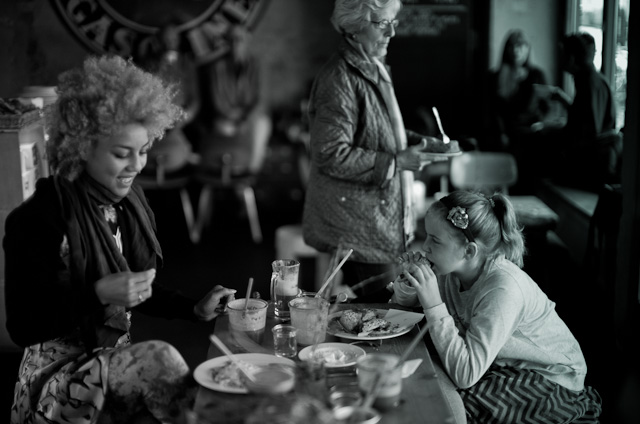
Breakfast at Aroma Kaffebar in Munich. ISO 3200. Leica M 246 Monochrom with Leica 50mm Noctilux-M ASPH f/0.95
The US Library of Congress states that DNG is a recommended alternative to other raw image formats:
"Less desirable file formats: RAW; Suggested alternatives: DNG".
The Digital Photography Best Practices and Workflow (dpBestflow) project, funded by the United States Library of Congress and run by the American Society of Media Photographers (ASMP), singles out DNG, and states "DNG files have proven to be significantly more useful than the proprietary raw files in our workflow"
As covered in my Lightroom Survival Kit 6 one should not depend on a raw/DNG format to be a usable standard in all future. This means that one should use Lightroom (or Capture One, Aperture or similar raw workflow tool) to read the raw/DNG files, edit them and then export them to a format that can be read in the future, and/or that can easily be converted to a new standard of file format. In short, I suggest one finish editing of ones images every day, export hires JPG files as final digital 'prints' (and still keep the raw/DNG files for reference and eventual later use).
But consider the hires JPG your original. In the same manner that you would always keep all your film negatives but would rely on printed images to be originals (as the world will one day run out of enlargers, photo paper, chemicals and people who now how to use them).
Leica Monochrom Masterclass
I will be writing more about the Leica M Monochrom Type 246 in the coming months, particularly about editing the images towards a special film look and monochrome look using Lightroom 6 (Lightroom CC). I will also be addressing how to get a monochrome look from the Leica M 240.
For more info on Paris Masterclass, have a look here:
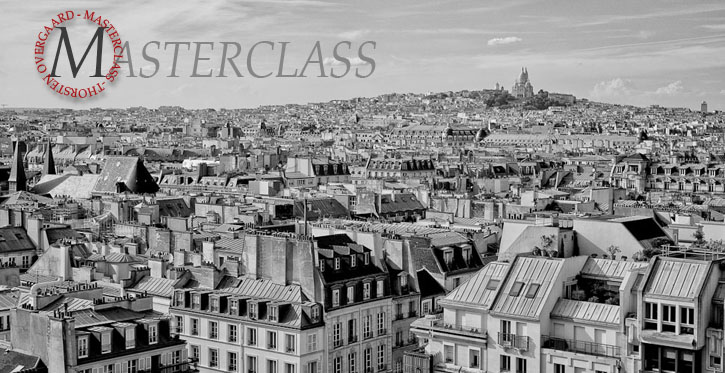
Always wear a camera - and be ready
I wear a camera most of the time, including in the car and in airplanes. That means that I have the camera strap across the chest so that the camera rests but is always there. I can sling it back so it isn't seen and isn't in the way. Or I have it in the front so it is more visible and ready. Some like to carry the camera in a hand-strap but I prefer to have both hands free and the camera 'next to me.'
My camera is always on and I don't use lens caps.
In the suggested Menu settings below you can see I have the camera to power off after two minutes and the preview is 1 second. This will make the camera battery last for a day, easily.
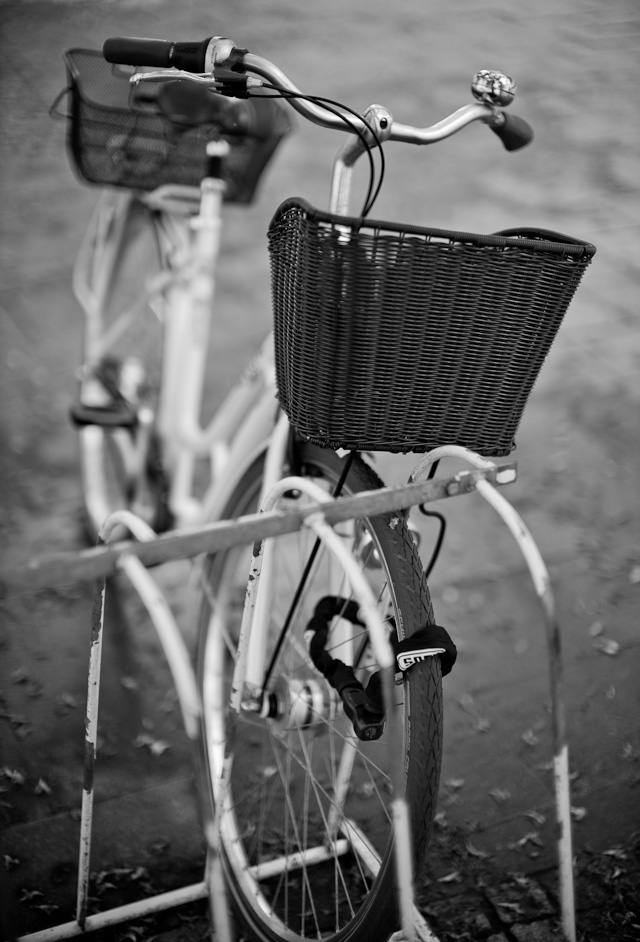
ISO 400. Leica M 246 Monochrom with Leica 50mm Noctilux-M ASPH f/0.95
To get started: Basic Menu setup for the Leica M Type 246
For the Leica M 240 user it is all natural and makes the Leica M 246 easy to use.
For the Leica M Monochrom user, the Leica M 246 will take a little time to get used to when coming from the Leica MM. The camera will confuse you the first days or weeks that the preview button on the back has now moved one step down and the top left button to the display is LV (Live View) that will activate the shutter with a click and show a preview of Live View on the display. But you will get used to it.
Next thing for the MM user to get used to is the new and expanded menu. For the Leica M 240 user it has a couple of new things to ay attention to.
To get started with the menu (Firmware Version 1.0.0.4)
This is the basic setup I recommend. If you set your camera like this it will work. The battery time will be long, the preview will be black and white ... this will get you started and you can start examining the menu items your self.
(For basic video settings, see page 36 of this review/article).
There is a SET and a MENU button on the back of the camera.
 The SET screen is quite simple one screen: The SET screen is quite simple one screen:
 |
SET screen 1 of 1 |
 |
 |
|
 |
 |
320 |
 |
File Format |
DNG + JPEG fine |
 |
JPEG Resolution |
24 MP |
 |
Video Resolution |
1080p@25fps |
 |
Exposure Bracketing |
Off |
 |
Exposure Compensation |
Off |
 |
Exposure Metering |
Center-weighted |
 |
User Profile |
--- |
|
 |
 |
 |
 |
|
|
 |
|
 |
* If you live in the US or Japan, the Video Resolution should be 1080p@24fps.
I will recommend File Format set to DNG, but for the first weeks or so I would use DNG + JPEG fine simply to be able to see the DNG and the JPG file side by side in Lightroom. The JPG has been "finished" by the camera firmware (based on pre-settings defined by Leica Camera AG) and is a little darker and more contrasty than the DNG. This will show what you minimum what can accomplish when you edit the DNG file.
You could say that you haven't graduated your DNG editing in Lightroom before your DNG files looks considerable better than the JPGs the camera makes. .
| The DNG file looks like this straight out of camera: |
|
The JPG file looks like this straight out of camera: |
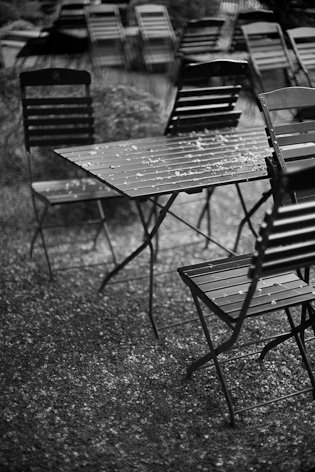 |
|
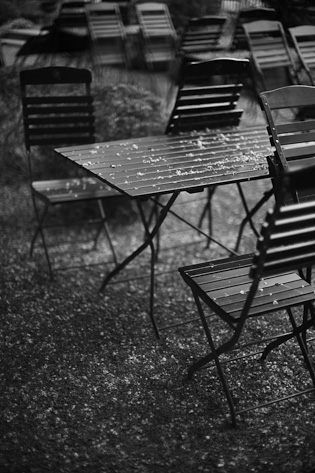 |
| |
|
|
 The MENU screen consist of five screens. The MENU screen consist of five screens.
Notice that as you scroll down the menu, the page indicator on the left changes (yellow here but white on the camera), and the subject/title on the top of the page changes:
 |
Menu screen 1/5 "Camera" |
 |
 |
|
 |
 |
Automatic |
 |
Self Timer |
12 s |
 |
Light Metering Mode |
Classic |
 |
Flash Sync. Mode |
Start of Exp. |
 |
Flash Exp. Compensation |
Off |
 |
Auto Slow Sync. |
1 / focal length |
 |
|
|
 |
|
|
|
 |
 |
 |
 |
|
|
 |
|
 |
 |
Menu screen 2/5 "Image" |
 |
 |
|
 |
 |
Standard |
 |
Contrast |
Standard |
 |
Contrast |
Standard |
 |
Toning |
Off |
 |
Shading Correction |
Off |
 |
DNG Compression |
On |
 |
|
|
 |
|
|
|
 |
 |
 |
 |
|
|
 |
|
 |
 |
Menu screen 3/5 "Setup" |
 |
 |
|
 |
 |
Medium |
 |
EVF Brightness |
Medium low |
 |
Frameline Color |
Red |
 |
Focus Peaking |
Red |
 |
Focus Aid |
Automatic |
 |
Clipping Definition |
2 / 253 |
 |
Auto Review |
1 s |
 |
|
|
|
 |
 |
 |
 |
|
|
 |
|
 |
 |
Menu screen 4/5 "Setup" |
 |
 |
|
 |
 |
Off |
 |
Image Numbering |
LEICA / M246 |
 |
Horizon |
On |
 |
Sensor Cleaning |
|
 |
GPS |
On |
 |
Audio |
Standard / Off |
 |
Exposure Simulation |
Rel. half pressed |
 |
|
|
|
 |
 |
 |
 |
|
|
 |
|
 |
 |
Menu screen 5/5 "Setup" |
 |
 |
|
 |
 |
2 minutes |
 |
Date / Time |
|
 |
Acoustic Signal |
Off |
 |
Language |
English |
 |
USB Mode |
PTP |
 |
Reset |
|
 |
Format SD Card |
|
 |
Firmware |
1.0.0.4 |
|
 |
 |
 |
 |
|
|
 |
|
 |
I shall get back to more on the menu and what each menu item does in a later article.
Installing Firmware updates
When there is a new release of firmware for the Leica M 246 Leica Camera AG will announce the first firmware update at the website. Here is a quick guide on how to install a new firmware after you have downloaded it to the computer:
-
Format an SD memory card in your Leica M.
-
Turn off the camera and insert the card into an SD card reader – either integrated or connected to your computer. (A reader is required for Firmware updates).
-
Download the Firmware file from the Leica M site using the “DOWNLOAD” link.
-
Save the .FW file at the top level of the card’s folder structure.
-
Remove the card properly from your card reader, insert the card into the camera and close the bottom cover.
-
Press the “INFO” button and hold it, simultaneously turn on the camera using the main switch.
-
The update process takes 2 - 4 minutes.
-
When the update is done, a corresponding message appears on the screen. The Message disappears after some seconds.
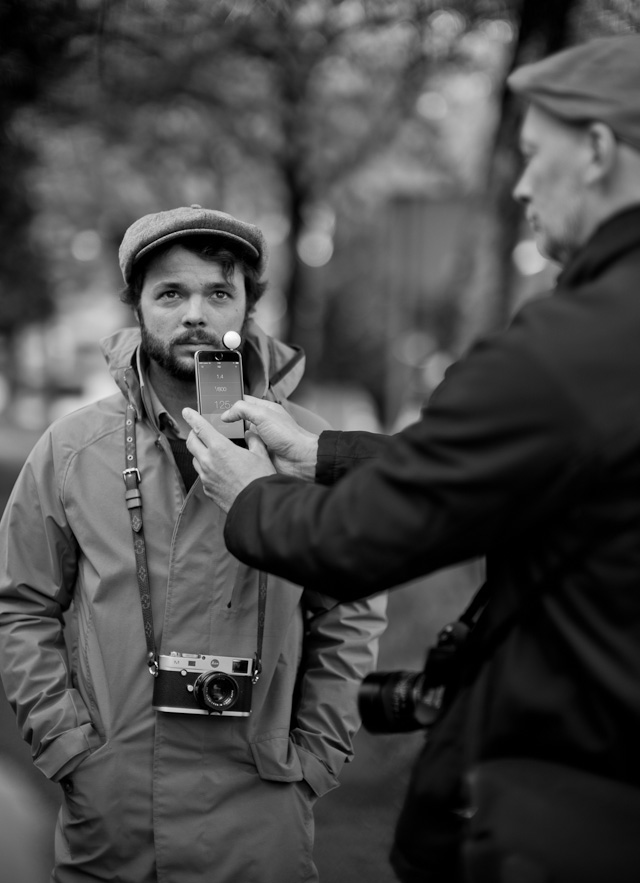
Harald Claessen taking a light reading with the LUMU light meter on David Innerhofe in the Munich Workshop. ISO 400. Leica M 246 Monochrom with Leica 50mm Noctilux-M ASPH f/0.95
Comments
As always, feel free to send me an e-mail with comments, suggestions, ideas, corrections
Index of Thorsten Overgaard's user review pages on Leica M9, Leica M9-P, Leica M-E, Leica M9 Monochrom, Leica M10, Leica M10-P, Leica M10-D, Leica M10-R, Leica M10 Monohcrom, Leica M11, Leica M11-D, Leica M 240, Leica M-D 262, Leica M Monochrom 246, Leica SL, Leica SL2, Leica SL2-S, Leica SL3, Leica SL3-S as well as Leica TL2, Leica CL, Leica Q, Leica Q2, Leica Q2 Monochrom, Leica Q3 and Leica Q3 43:
|
![]()
